
 |
The Chinese prints from Zhou Han’s pamphlet, In Accord with the Imperial Edict: Complete Illustrations of the Heretical Religion, were reproduced in reverse order (32-1) in Griffith John’s 1891 book, The Cause of the Riots in the Yangtse Valley: A “Complete Picture Gallery” (available in full elsewhere in this unit). Here, the prints—with transcriptions of Griffith John’s translations and notes pages—appear in the original order, as numbered (1-32). |
Warning: On viewing images of a potentially disturbing nature. |
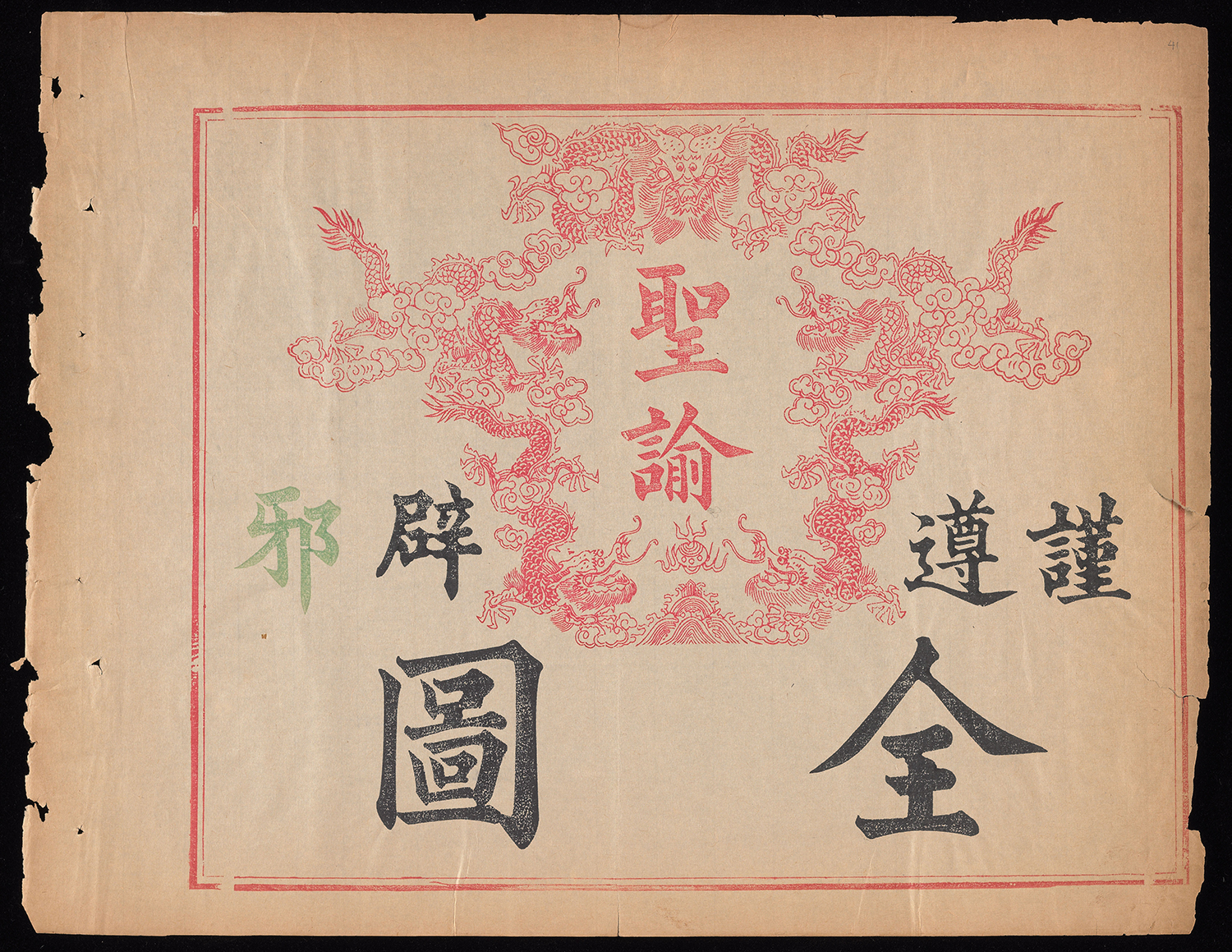 |
Title Page Transcription of Caption [cr76] for Title Page [cr80]: TRANSLATION OF TITLE PAGE. 謹遵聖諭辟邪全圖 HERESY EXPOSED IN RESPECTFUL OBEDIENCE TO THE SACRED EDICT. A COMPLETE PICURE GALLERY. NOTE. “The Sacred Edict, so called because written by two of the canonized Emperors of the present dynasty, is a kind of paternal address from the Throne to the people, and is held in the greatest reverence by the Chinese. In 1670, the Emperor Kang-hi published a hortatory edict in sixteen sections of seven words each. His son Yung-cheng published, in 1724, an amplification of these edicts, being sixteen lectures on the sixteen texts of his father. These lectures with the themes on which they were written constitute what is called The Sacred Edict. One of these chapters, or lectures, is made use of as an introduction to his book (Death Blow To Corrupt Doctrines) with the view of giving it the highest possible sanction. Artful allusions are made to it in different parts of this book, with the design of convincing the reader that to drive out foreigners and their religions would be but carrying out the views of the most renowned Emperors of Chinese history.” See Death Blow To Corrupt Doctrines, page 1. Translated from the Chinese at Teng-chow, and published at Shanghai in 1870. TRANSLATION AND NOTES. “Among all the numerous writings,” says Williams in his Middle Kingdom, “published for the improvement and instruction of the people by their rulers, none has been so celebrated as the Sheng-Yü, or Sacred Commands. In order that none should plead ignorance for not knowing the sacred commands, it is by law required that they be proclaimed throughout the empire, by the local officers, on the first and fifteenth day of every month, in a public hall set apart for the purpose, when the people are not only permitted, but requested and encouraged, to attend.” The chapter made use of as an introduction to the Death Blow To Corrupt Doctrines is the seventh, and has for its theme:—“Suppress strange religions for the purpose of exalting orthodox doctrine.” In this chapter, Christianity is classed among the strange religions which are not to be followed by the Chinese people. The following extract from this Chapter will give the reader some idea of its bearing on the antichristian literature which has been flooding the country of late. The extract is taken almost verbatim from the translation given by the translators of the Death Blow To Corrupt Doctrines. It reads thus: “With respect to heterodox books not in accordance with the teaching of the sages, and those tending to excite and disturb the people, to give rise to differences and irregularities, and to undermine the foundations of all things; all such teach corrupt and dangerous doctrines, which must be suppressed and exterminated. ... ... From ancient times the three religions have been propagated together. Besides Confucianism, which holds the preeminence, we have Buddhism and Taoism. ... ... There is, however, a class of vagabond adventurers who under the pretence of teaching these systems (Buddhism and Taoism) bring them into the greatest disrepute, making false parade of what is propitious and what is unpropitious, and of future rewards and punishments, for the purpose of giving currency to their foolish and unfounded stories. Their object in the beginning is to make a living. By degrees they collect men and women into promiscuous gatherings for the purpose of burning incense. ... ... the worst of all is that there lurk within these assemblies treacherous, depraved, and designing persons, who form dangerous combinations, and pledge themselves to each other by oaths. They meet in darkness and disperse at dawn. They imperil their lives, sin against righteousness, and deceive and entrap the people. ... ... Such is the Peh-lien, the Wen-hiang, and similar religions. They should be a beacon of warning to you. Such also is the religion of the West, which reverses the Lord of Heaven, T’ien Chu. It also is not to be regarded as orthodox. Because its teachers were well versed in mathematics, our Government made use of them, of this you must not be ignorant. As to unauthorized doctrines which deceive the people, our laws cannot tolerate them; for false and corrupt teachers out Government has fixed punishments.” The above extract will suffice to show what a powerful weapon the antichristian agitation finds in the Sheng-Yü. In the Hunan publications, it is frequently referred to in justification of the antichristian movement. The very title page of this pictorial work tells us in what light the author regards his attack on the foreigner and the foreign religion. He looks upon himself as simply acting in compliance with the Imperial Commands, as given in The Sacred Edict. Has the time not come when the Chinese government should be asked by the Foreign Powers to expunge from the Sheng-Yü its every hostile reference to Christianity, and to bring it into harmony with the Imperial Edict issued this year? If Christianity is allowed to continue to appear as proscribed religion in the Sheng-Yü, the recent Imperial Edict will soon become a dead letter, so far as the people are concerned. The author of this pictorial work is probably Chou Han, 周漢, an expectant Taotai, and a native of Ning-hiang in Hunan. He is Imperially honoured with the second rank, and wears a red button. He seems to be the leader in the present antichristian agitation. For further information concerning him see North China Herald of October 30th, and December 18th, 1891. [cr80_1891_Hankow] |
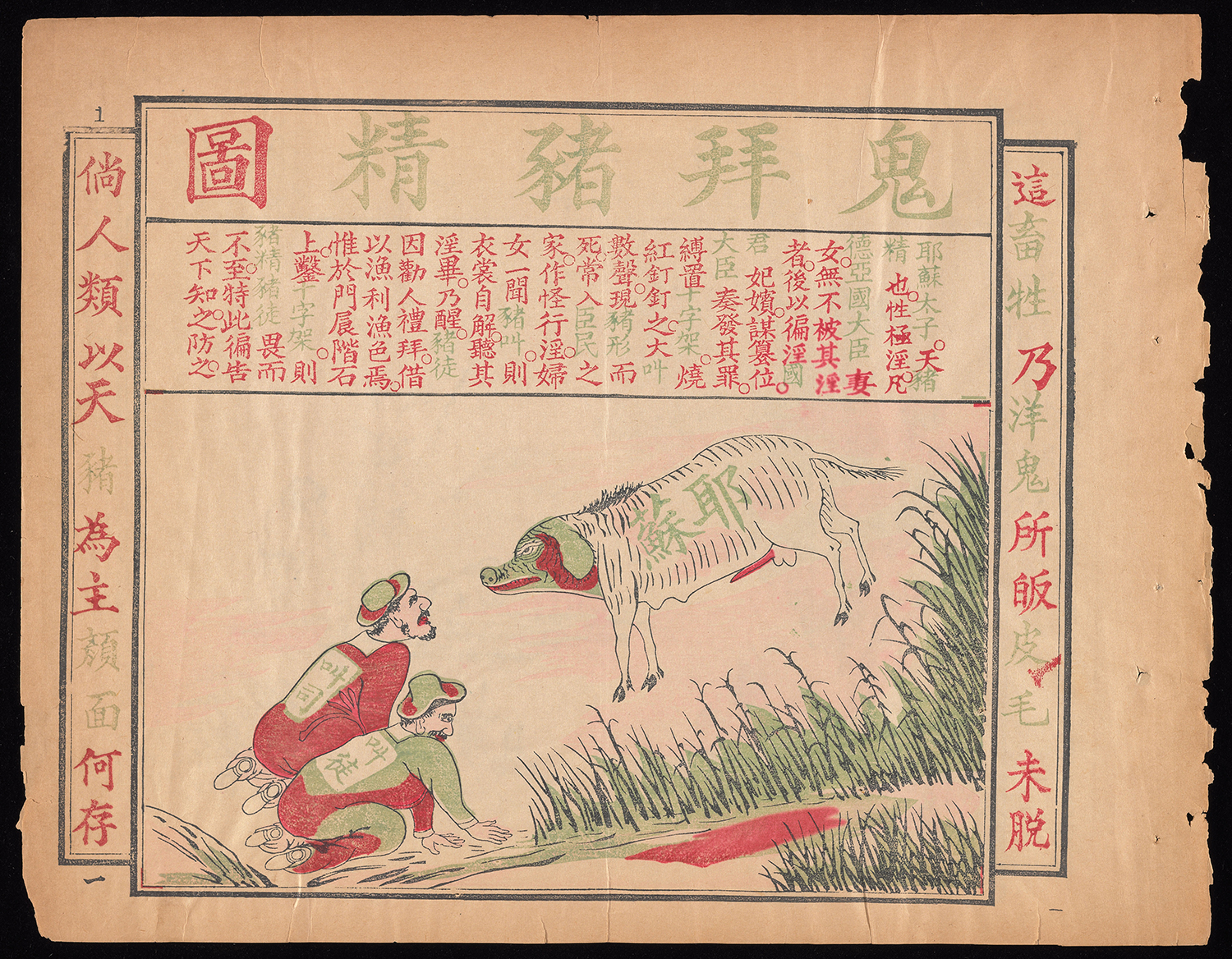 |
Picture 01 Transcription of Caption [cr79] for Picture 01 [cr75]: PICTURE I. TRANSLATION. NOTE. Top:—The Devils (foreigners) Worshipping the Hog (Jesus). Right hand column:—This is the beast which the foreign devils follow; the hog’s skin and bristles are still upon him. Left hand Column:—If human beings will take the Celestial Hog for Lord, how will they retain the human countenance? Text in middle:—A Special announcement. Jesus, Heir Apparent (to the throne of Judea), was a metamorphosis of the Celestial Hog. His nature was extremely lascivious. All the wives and daughters of the high officials of Judea were, without exception, debauched by him. Having debauched all the concubines of the sovereign, and having plotted to seize the throne, the high officials sent up a report of his crimes in a memorial. He was then bound, placed on a cross, and nailed to it with red hot nails. He uttered a number of cries, revealed his hog form and died. After this he constantly entered the houses of the high officials, doing strange things, and committing lewdness. The moment married women and maiden heard the Hog’s squeak, their dress will unfasten of itself, and not until he had satiated his lust would they wake up to consciousness. This is the reason why the disciples of the Hog exhort people to come and worship; it is that they may avail themselves of the opportunity to seek for gain and indulge in lust. If a cross is cut on the door-sill and door-steps, the Hog and his disciples will be seized with fear, and not approach. This is a special announcement for the information of all, so that they may know, and be on their guard. NOTES. 1. The Celestial Hog. The term used for God by the Roman Catholics is T’ien Chu, 天主. It is also used for our Lord Jesus Christ. In these Hunan publications Chu, 主, for Lord is changed into chu, 豬, for pig, and thus T’ien Chu, 天主, the Lord of Heaven, becomes T’ien chu, 天豬, the Celestial Hog. 2. The characters on the Hog are Ye-su, 耶穌, the term used in China for Jesus. The crouching figures are two foreigners, the one marked Teacher, and the other Disciple. Both are worshipping the Hog. 3. Green hat is a name in China for a cuckold, more commonly called Wang- pah, 耶穌, i.e. one who forgets all the eight virtues. Hence the green hats worn by these two foreigners. For the same reason all words referring to the foreigner, the foreign religion, and the Christian convert, are in the text printed with green ink. To call a man a Wang-pah, or Luh-mau (green-hat), is the greatest insult you can offer him in China. 4. Devils. In China foreigners are often called Kuei, 鬼. Williams in his Syllabic Dictionary defines the word thus:—“The spirit of a dead man before it is enshrined in the all; a manes, that which the soul turns to at death; a ghost, a goblin, an apparition, a spectre, a devil; a horrid repulsive object; a sordid wretch. Foreigners are so stigmatised, because (so the Cantonese say), their blue eyes suggested the malice, and their shrill voice the plaintive cry of ghosts.” As applied to foreigners it is a term of extreme hatred and contempt. [cr75_01picture_1891] |
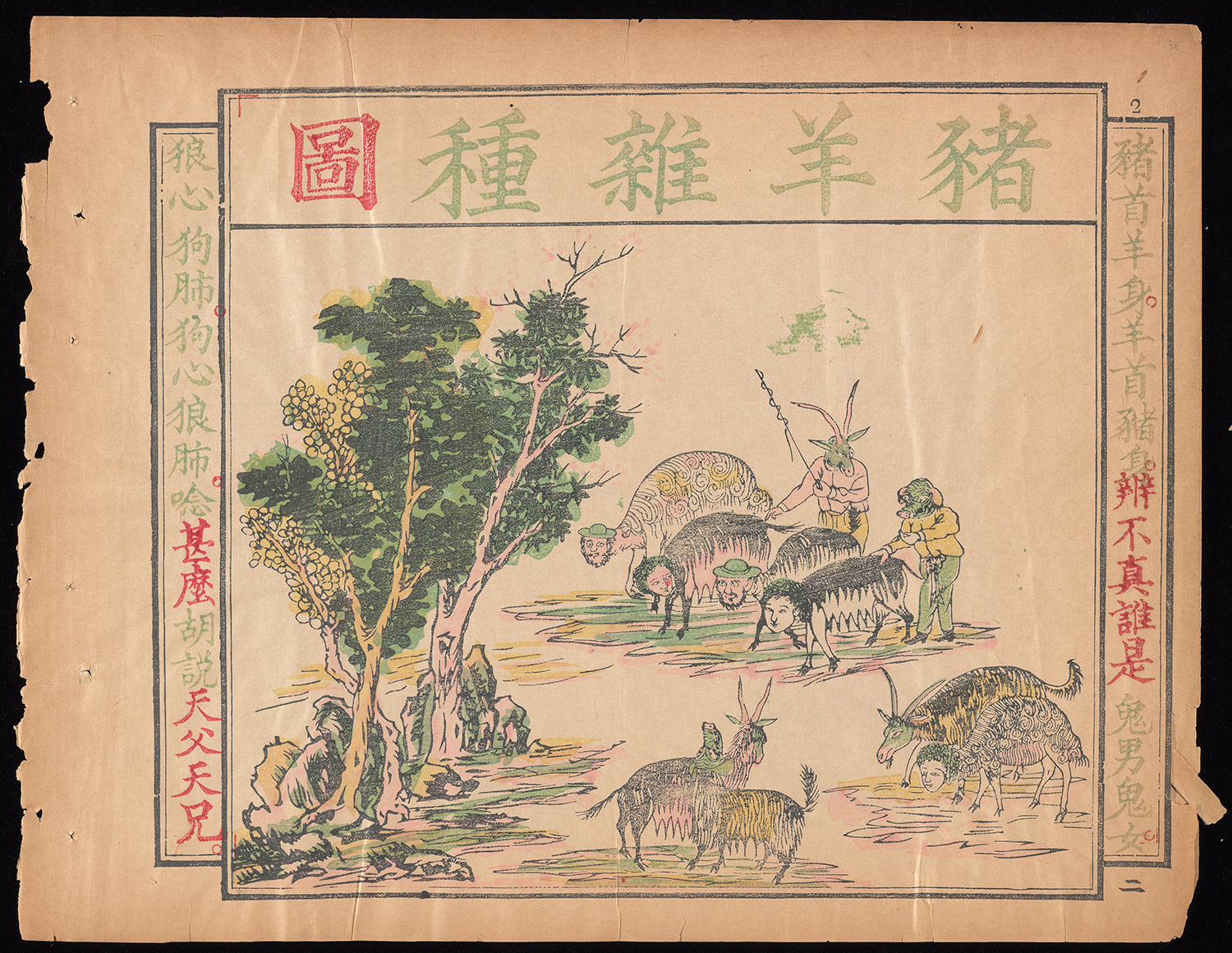 |
Picture 02 Transcription of Caption [cr73] for Picture 02 [cr74]: PICTURE II. TRANSLATION. Top:—The Pig-goat Bastards. Right:—Some have pig-heads and goat-bodies; some have goat-heads and pig-bodies. Cannot tell which is devil male, and which is devil female. Left:—Some have wolf-hearts and dog-lungs; some have dog-hearts and wolf-lungs. What nonsense they talk about Heavenly father, and Heavenly elder brother. NOTE. Foreigners in China are called Yang-jen, 洋人 , ocean men. In the Hunan publications Yang, 洋, for ocean is changed into Yang, 羊, for goat; thus ocean men becomes goat men. As foreigners we are in contempt called goats, and as Christians we are called pigs. [cr74_02picture_1891.jpg] |
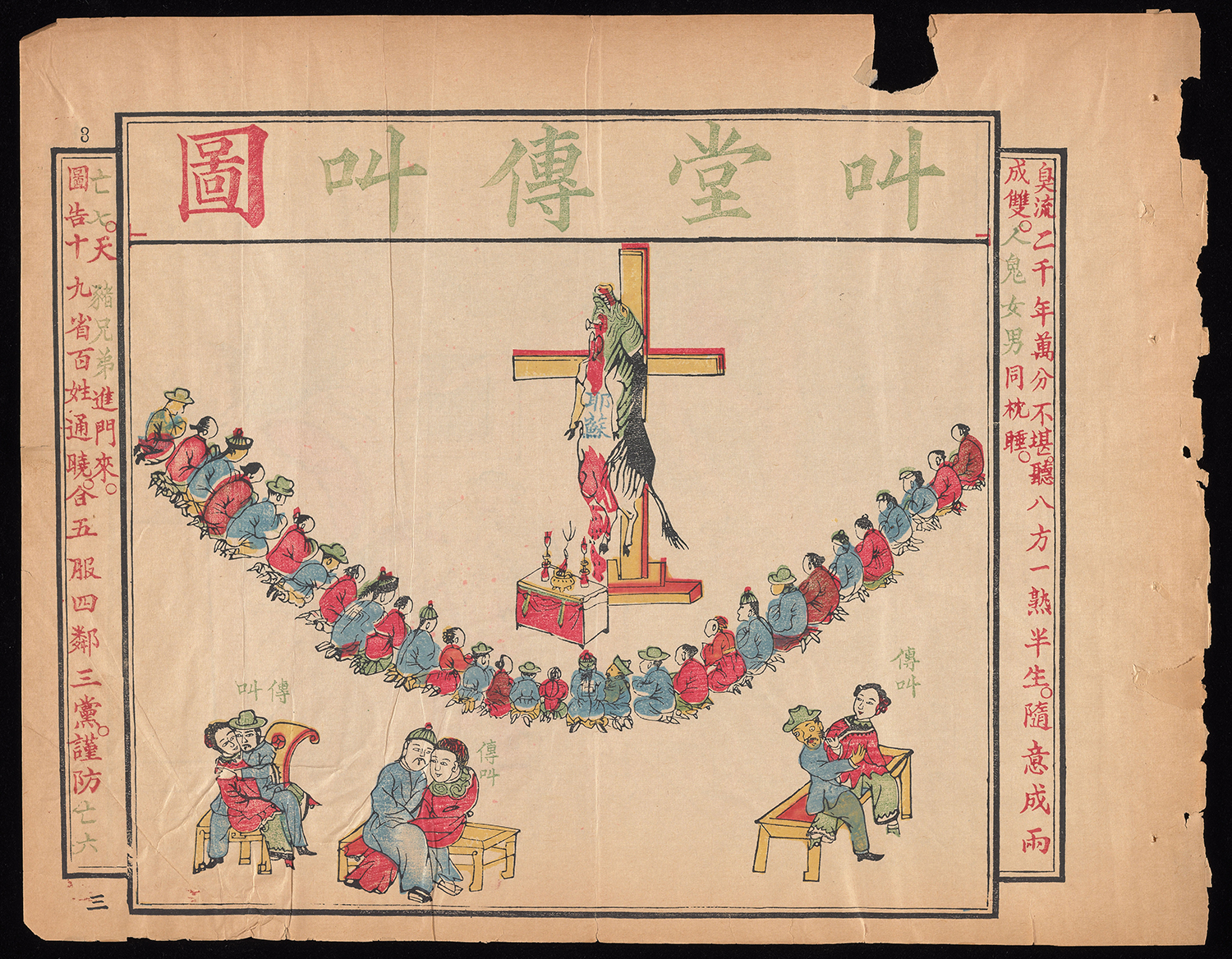
Picture 03 Transcription of Caption [cr72] for Picture 03 [cr71]: PICTURE III. TRANSLATION. Top:—Propagating Religion in the Chapels. Right:—The intolerable stench has flowed down two thousand years. People who, for the most part, are strangers to each other, meet from all quarters, and couple and pair just as they please; human beings and devils, male and female, sleep together on the same pillow. Left:—The pictorial representation is to inform the people of the nineteen provinces (all China), in order that all who are related to each other as kindred and neighbours may combine together, and diligently guard against cuckolds, lest the brothers of the Celestial Hog should enter their doors. NOTES. 1. Propagating religion in the Chapels, literally “propagating the squeak in the squeak halls.” The term T’ien-Chu Kiau, 天主教, the Religion of the Lord of Heaven, is the term adopted by the Roman Catholics for the Christian religion. In these publications Chu, 主, for Lord is changed into chu, 豬, for pig, and Kiau, 教, for Religion is changed into Kiau, 叫, for squeak; thus T’ien-Chu Kiau, 天主教, the Religion of the Lord of Heaven, becomes Tien-chu kiau, 天豬叫, the squeak of the Celestial Hog. 2. The characters on the crucified hog are Ye-su, 耶穌, Jesus. Those over the lewd figures are Chuen Kiau, 傳叫, and may be translated:—“This is the way they propagate their religion.” 3. In the Hunan publications the worship of Jesus is represented as the worship of licentiousness. Here Our Lord is portrayed as a hog, crucified on account of his licentiousness. He is surround by male and female worshippers, some on their knees, and some indulging in licentious merriment. “Every Sabbath day they perform worship which they call the mass. All work is suspended and old and young, men and women, assemble in the church. The leader of the service takes the principal seat, and extols the virtues of the head of the religion, the whole crowd also muttering prayers. When the ceremony is over, they give themselves up to indiscriminate sexual intercourse. This is the height of their enjoyment. They call it the Great- communion, or the Love-gathering.” So wrote the author of Death Blow To Corrupt Doctrines more than twenty years ago. In the Blue Books, 皇朝經世文, a Collection of Public Documents on all State Questions, we read:—“When the medicine (given by the teacher) begins to work, they (the converts) conduct themselves like madmen; they even go so far as to split up and destroy the spirit tablets of their ancestors. When the medicine gets a real hold of them, their minds become frenzied and they behave themselves like demons. Not only will they worship and fast, but joyfully obey the teacher’s order in all things; even if told to strip and expose their nakedness they will do so gladly—simply something monstrous must possess them. I have also heard that propagators of the religion travel over every province; they find their way among the hills and valleys, however deep and hollow. If anyone refuses to believe their religion then when he visits their chapels they secretly put medicine into his tea or cakes. Instantly the man’s natural disposition is changed, and he follows them without the least hesitation or doubt. As to men and women spending the night together in the same chapel, how do they manage to convey their feeling to each other? They do it thus. The teacher fixes his eyes upon the good-looking among the married women. When the time comes he gives her a cake with medicine in it. The woman unconscious of its nature swallow it. The medicine is able to excite thoughts natural to the spring (sexual desires), and like the pheasant she begins to call for her mate. It is probably a sort of love-potion, and may be called “poison acting as a go between.” [cr71_03picture_1891] |
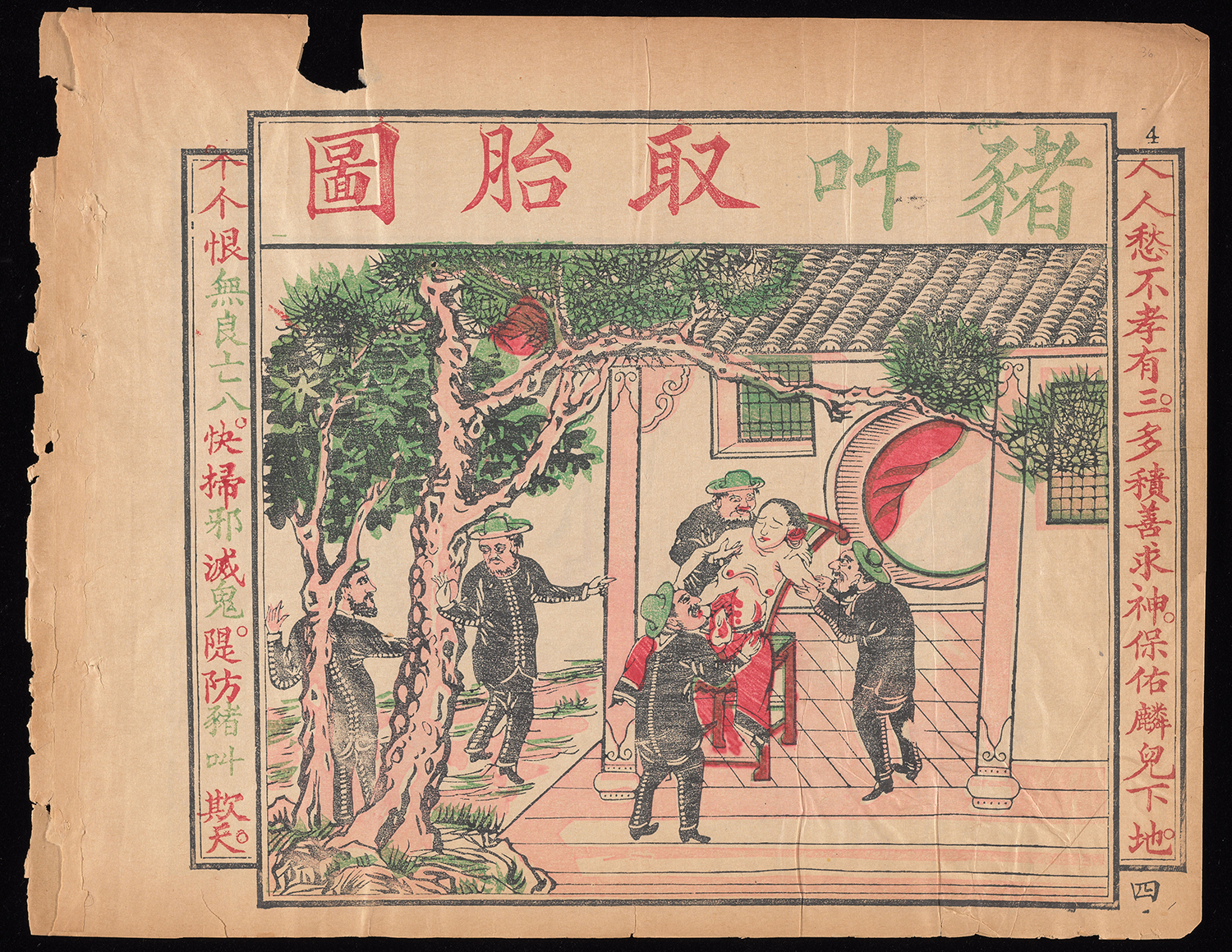
Picture 04 Transcription of Caption [cr69] for Picture 04 [cr70]: PICTURE IV. TRANSLATION. Top:—The Hog Sect Extracting the Fetus. Right:—All men are anxious in regard to the three things which are unfilial; they amass good deeds and pray to the gods in order that they may be blessed with sons. Left:—Everyone hates the conscienceless cuckold. Hasten to sweep away the heresy, and exterminate the devils; be on your guard and do not let the Hog Sect insult Heaven. NOTES. 1. One of the charges brought against foreigners, in these Hunan publications, is that they extract the placenta and the fetus for medicinal purposes. In Death to the Devils’ Religion, 鬼教該死, it is stated that the Devil-sect has a black-art by which the fetus can be extracted, the nipples cut off, and the testicles removed. These are sold to devil-merchants, and used by photographers for chemical purposes. They are also compounded with lead in order to obtain silver. Here the foreigners are represented as actually engaged in the diabolical work. 2. The three things which are unfilial. Mencius said:—“There are three things which are unfilial, and to have no posterity is the greatest of them.” The reference here is to the greatest. [cr70_04picture_1891] |
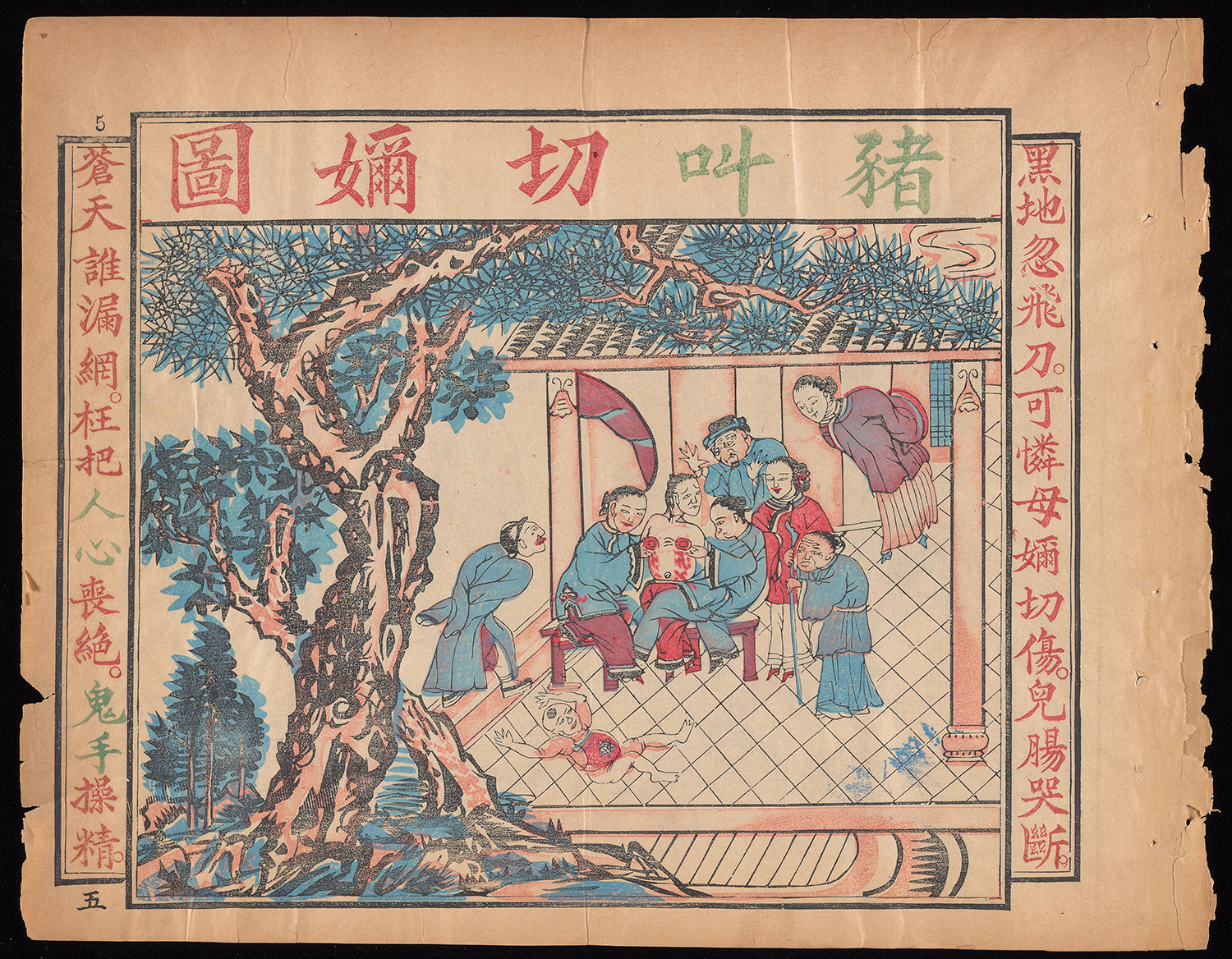 |
Picture 05 Transcription of Caption [cr68] for Picture 05 [cr67]: PICTURE V. TRANSLATION. Top:—The Hog Sect Cutting the Nipples. Right:—Suddenly does the knife fly in the dark. Alas! the mother’s breast is sadly bruised, and the child’s heart (bowels) is broken with crying. Left:—Who can evade the punishment (escape the net) of High Heaven? In vain do you (foreigners) destroy your human feelings; useless is the dexterity of your devil-hands. NOTE. See note to the preceding Picture. [cr67_05picture_1891] |
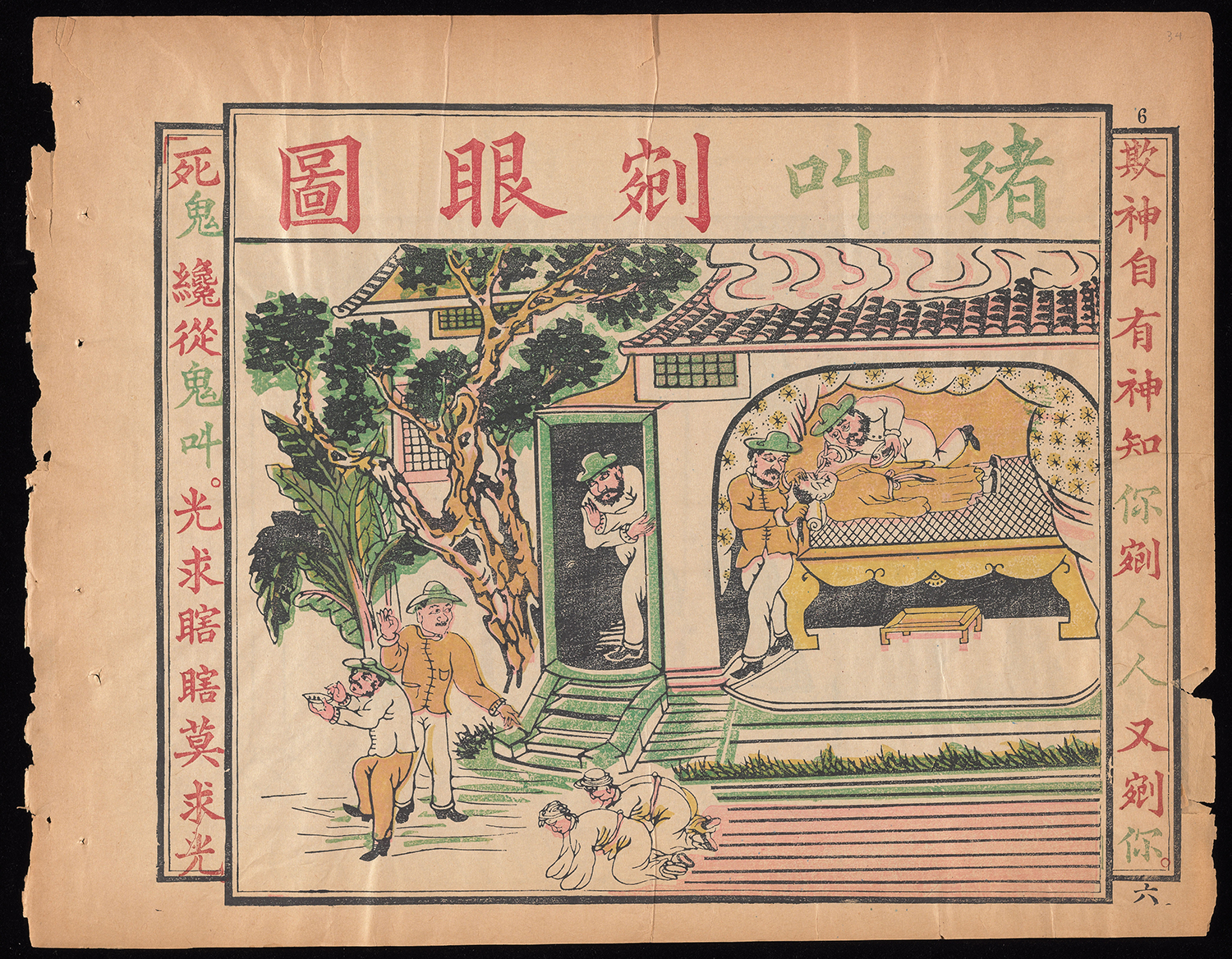 |
Picture 06 Transcription of Caption [cr65] for Picture 06 [cr66]: PICTURE VI. TRANSLATION. Top:—The Hog Sect Gouging the Eyes. Right:—You foreigners would deceive the gods, but the gods surely know; you scoop out the eyes of men, and men will scoop out your eyes. Left:—Dead devils (native converts) who have just joined the devil-sect! Be it known to you that those who have sight may seek blindness, but in vain will the blind seek sight. NOTES. 1. Dead devils. Native converts are called so because they are regarded as dead to all virtue, and to be worthy of death. 2. The cartoon represents two foreigners in the very act of gouging out the eyes of a man. The crouching figures are two blind men whose eyes have been scooped out, and are now in the possession of the two foreigners, after whom the blind men are crawling. 3. In the Death Blow to Corrupt Doctrines we read:—“In case of funerals the religious teachers eject all the relatives and friends from the house, and the corpse is put into the coffin with closed doors. Both eyes are secretly taken out, and the orifice sealed up with plaster. This is what is called ‘sealing the eyes for the western journey.’ ... ... The reason for extracting the eyes is this. From one hundred pounds of Chinese lead, eight pounds of silver can be extracted, and the remaining ninety two pounds of lead can be sold at the original cast. But the only way to obtain this silver is by compounding the lead with the eyes of Chinamen. The eyes of foreigners are of no use for this purpose, hence they do not take out the eyes of their own people, but only those of the Chinese. The method by which the silver is obtained has never been discovered by any of the native Christians during the long period in which this religion has been propagated here.” In the Blue Books, 皇朝經世文, a Collection of Public Documents on all State Questions, we read: — “When the priest receives a convert, the convert is said to ‘eat the religion.’ On putting down his name he receives for taels in silver. ... When any of them dies, the priest sends someone to enshroud the body. He drives away all the kindred of the deceased, and the enshrouding takes place. When that is finished, two plasters are used to cover the eyes of the corpse. It is then wrapped up in a red cloth bag, which is sown up round the neck, and put into the coffin. It is said that they use this enshrouding process as a blind for scooping out the eyes of the dead, which are used in refining silver. When the converts are alive, they receive four taels in silver, with this object in view.” The above extracts speak of the gouging of dead men’s eyes only. In the more recent of the Hunan publications the foreigners are spoken of as gouging the eyes of living men also. See note on Cartoon IV. [cr66_06picture_1891] |
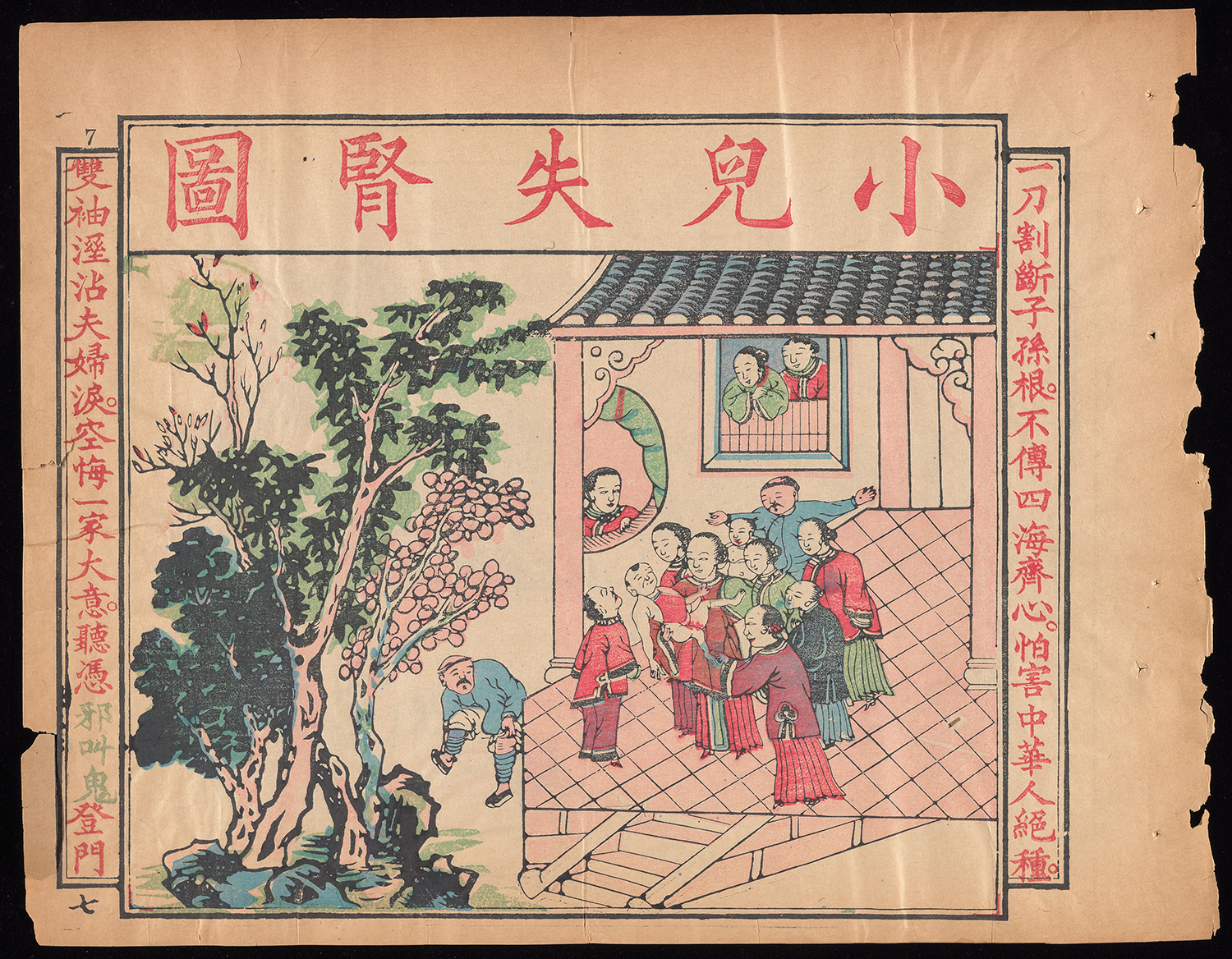 |
Picture 07 Transcription of Caption [cr64] for Picture 07 [cr63]: PICTURE VII. TRANSLATION. Top:—A Little Boy Losing His Testicles. Right:—With one stroke of the knife posterity’s root is cut off; if all within the Four Seas are not summoned to unite their hearts, it is to be feared that the seed of the Chinese race will be exterminated. Left:—Both sleeves are saturated with the tears of husband and wife; it is vain to regret the thoughtlessness of the entire family in allowing the devils of the depraved religion to enter the door. NOTES. 1. In Death Blow To Corrupt Doctrines, we read:— “They even cut out the ovaries of girls, emasculate boys, and use different methods to obtain the brains, hearts, livers, etc., of children. It is impossible to enumerate all these practices. If we seek for the general motive which leads them to do so, it is a fixed determination utterly to befool our people, and under false pretence of religion to exterminate them. Thus they wish to take possession of the Middle Kingdom.” 2. In the Blue Books of China, already referred to, we read:— “In my opinion the depraved sects in making charms and medicines use certain parts of the human body and mix them with brains. ... They begin by taking what they want from the dead, but if that does not do they take it from the living; therefore they stupefy children and mutilate them while the life is in their bodies. ... Of the Foreign Missionaries who come to China since the repeal of regulations prohibiting Christianity, the greater part are Frenchmen. Of late years the rumours of their taking out the brains of infants and mutilating girls have been scattered abroad, for in addition to building churches, they have now opened orphanages.” These Blue Books are deeply responsible for creating and fostering antiforeign sentiment in China. [cr63_07picture_1891] |
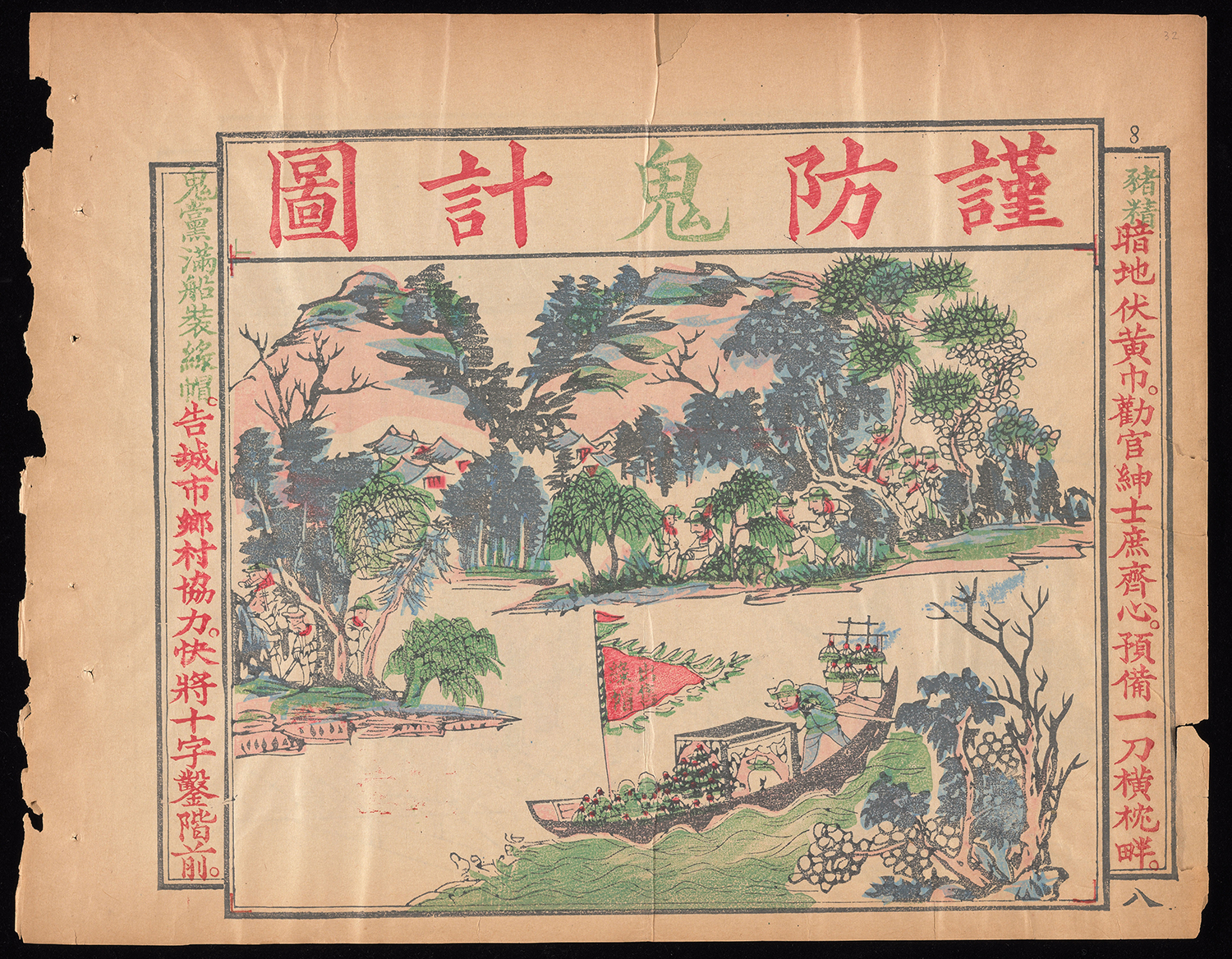
Picture 08 Transcription of Caption [cr61] for Picture 08 [cr62]: PICTURE VIII. TRANSLATION. Top:—Diligently Guard against the Devils’ Plot. Right:—The Hog has placed his Yellow Turbans in ambush; let the officials, gentry, scholars, and common people be united in heart, and each one have his sword in readiness alongside his pillow. Left:—The devils (Foreigners) have filled the boat with green hats; let the cities, towns and villages unite their strength, and instantly cut the figure of a cross in front of their doorsteps. NOTES. 1. The incident referred to in the text is this:— “Chang kioh, a native of North China, having obtained a great following during many years practice of the occult arts of Taoism, raised the standard of rebellion in A.D. 184, in conjunction with his brother Chang Pao, and in the space of a single month gained possession of all the Northern provinces. His adherents, divided under 36 commands, were distinguished by yellow turbans, and for a time carried all before them; but after some months sanguinary warfare the insurrection was suppressed and its leaders were slain.” See Mayers’ Chinese Reader’s Manual. The Hog has his Yellow Turbans also, and hence the necessity of watchfulness and preparation. There is here also a prophecy of the final overthrow of the Hog and his followers. 2. Green hats. Cuckolds are called green hats. Here the missionaries are represented as going about selling these hats, or making cuckolds their propagandism. In Death to the Devils’ Religion we have the following exhortation to husbands:— “The Christian sect bewitch men’s wives; the disgrace is terrible and not to be mentioned; let all the husbands keep their eyes open; let them be on their guard, lest their hats change their colour.” Thus to become a convert is to become a cuckold. 3. Cut the figure of a cross in front of the doorsteps. The Chinese have an idea that no Roman Catholic Christian dares tread on a cross-like figure, and that all they need do, in order to keep the Roman Catholic priest and his emissaries out of a house, is to so cut the figure in front of the door as to make it impossible for any one to enter without treading on it. See Cartoon I. [cr62_08picture_1891] |
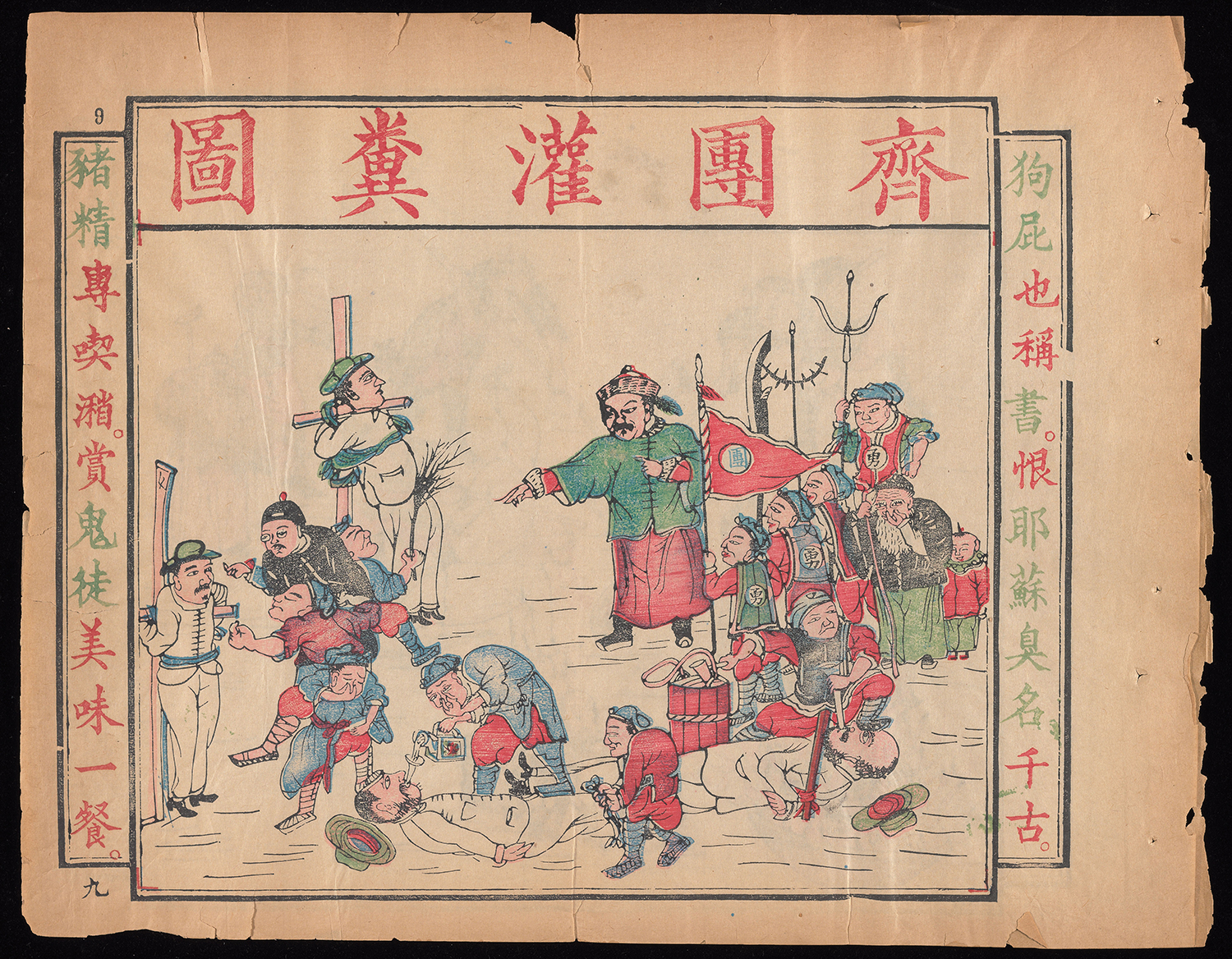 |
Picture 09 Transcription of Caption [cr60] for Picture 09 [cr59]: PICTURE IX. TRANSLATION. Top:—The Assembling of the Braves and the Dosing of the Devils with Dung. Right:—Mere dog-fart they call books; it is hateful that the stinking name of Jesus should descend a thousand generations. Left:—The Hog (Jesus) feeds only on rice-rinced water; we present his devil- followers with one well flavoured meal. NOTES. 1. This Cartoon represents foreigners as being punished in this way. They are first birched and then dosed. It is a punishment prescribed for native converts also, in order to induce them to abandon the faith. Death to the Devils’ Religion gives the following advice in regard to native converts: —“Members of the Christian sect are easily recognised. They do not reverence heaven, earth, prince, or parents; they burn not incense at the temples, nor set up halls for the worship of ancestors. Should there be at any place a man who acts thus, the members of his family are surely devils’ children (converts). Let him be bound instantly and be force to drink human dung. Then search his house thoroughly. Should the devils’ books be found in it, let them be thrown in the fire and burned. Draw the figure of a cross on the ground, make a likeness of the devil Jesus and place it on the cross. Then tell him (convert) to make water and void excrement on the Crucifix, and if he obeys, let him go. Should he refuse to obey, take him to the river’s brink, and see if the followers of the devils’ sect (converts) will not be struck with terror.” 2. It will be observed that the braves are led by a red buttoned mandarin, and that the punishment is ordered and regulated by him. This figure is intended, probably, to represent the famous Chou Han. [cr59_09picture_1891] |
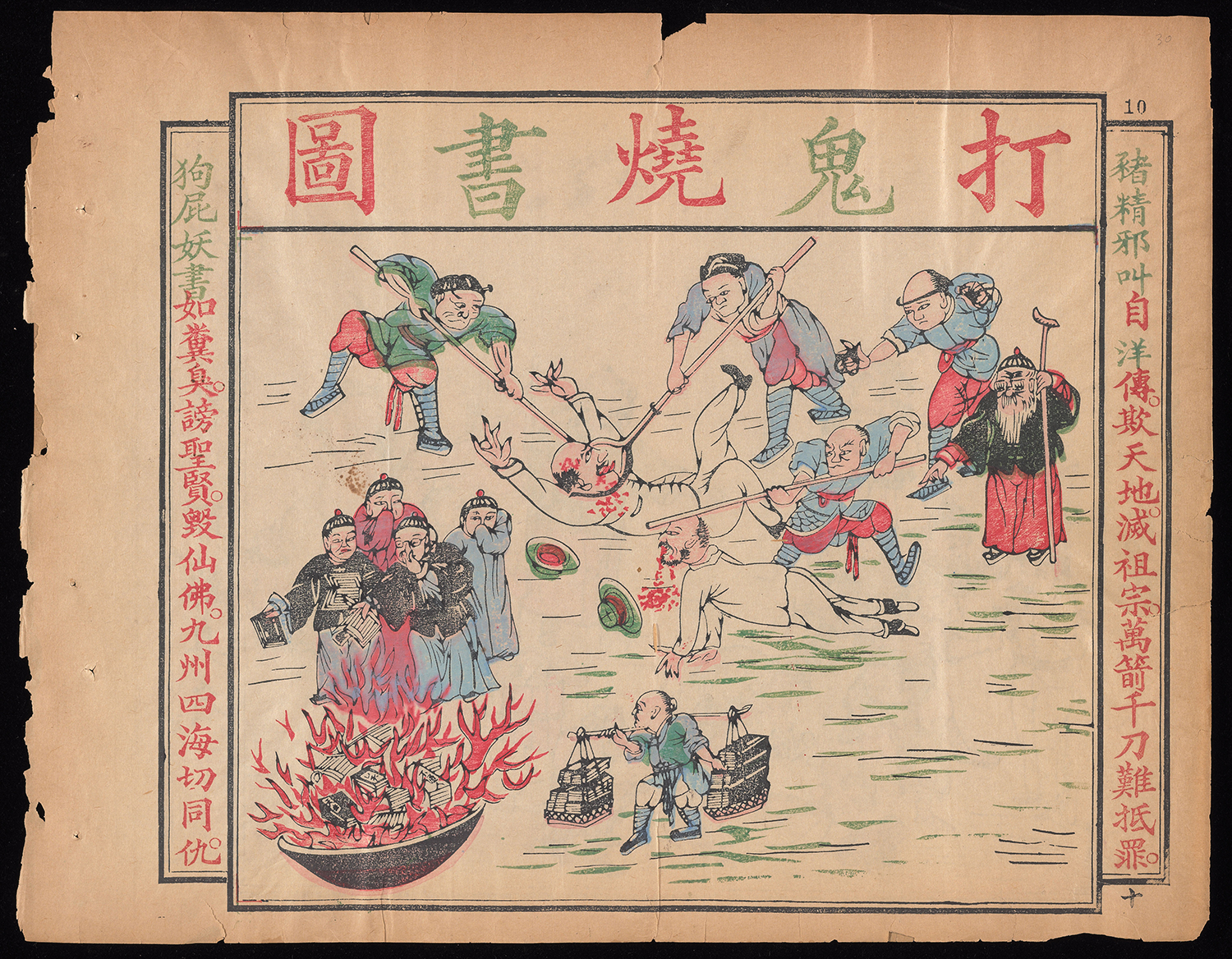 |
Picture 10 Transcription of Caption [cr57] for Picture 10 [cr58]: PICTURE X. TRANSLATION. Top:—The Beating of the Devils and the Burning of the Books. Right:—The depraved religion of the Hog (Jesus) is propagated from foreign lands. Its followers insult heaven and exterminate ancestors; ten thousand arrows and a thousand swords (the severest punishments) would not expiate their crimes. Left:—Their dog-fart magical books stink like dung; they slander the holy men and sages; they vilify the Genii and Buddhas; all the Nine Provinces and the Four Seas hate them most intensely. NOTE. The Nine Provinces: The nine divisions of China in the days of Yü. The Four Sea, used as a synonym for the Chinese empire. The two terms are often used as a designation for the whole Empire. The Devils are the foreigners. The Books are the Christian books. [cr58_10picture_1891] |
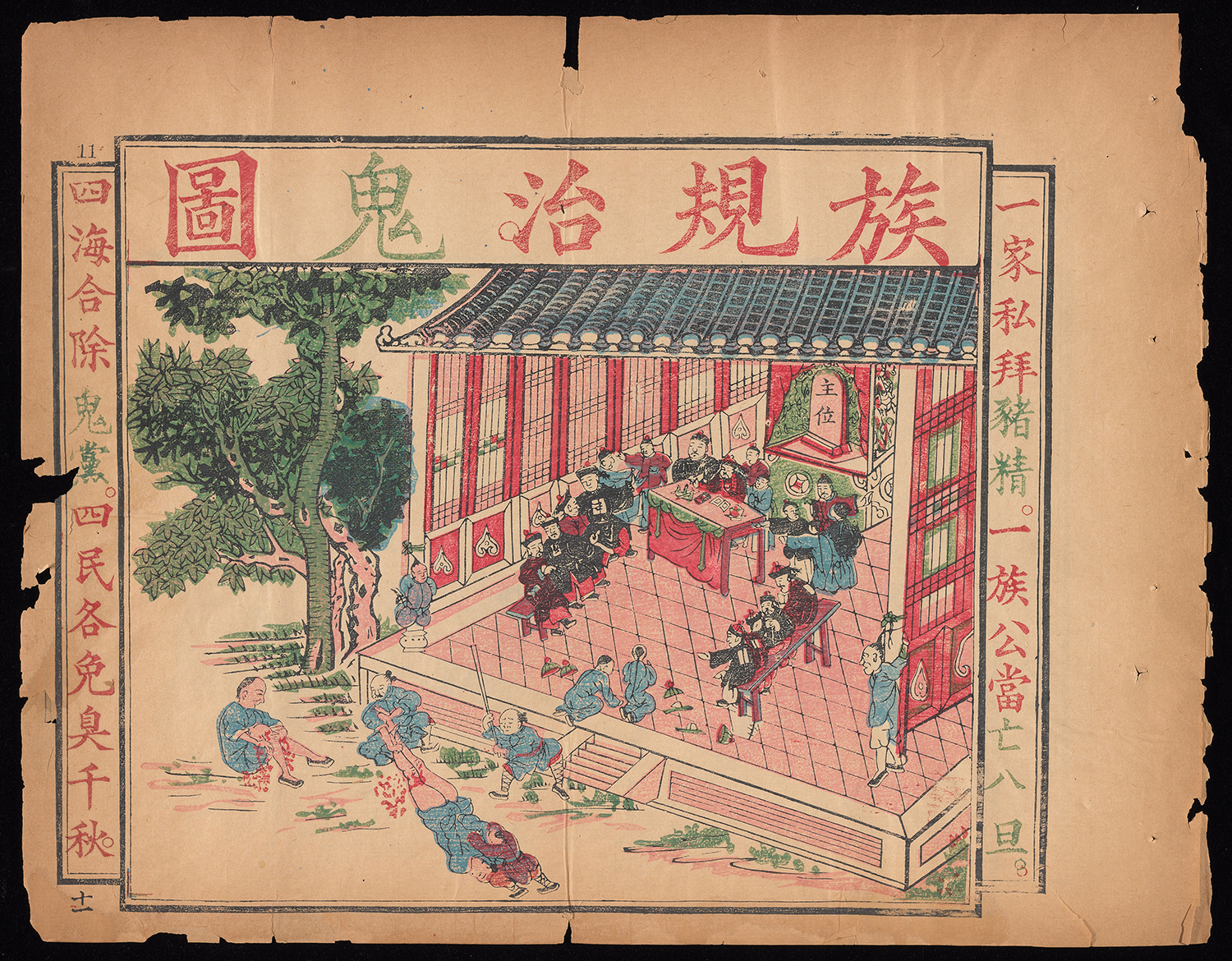
Picture 11 Transcription of Caption [cr56] for Picture 11 [cr55]: PICTURE XI. TRANSLATION. Top:—The Clan Law Administered to the Devil. Right:—If one family in a clan is found secretly worshipping the Hog, all the members of that clan are to be taken for cuckolds. Left:—Let all within the Four Seas unite together and eject the devil-faction, so that each of the four classes of Society (scholars, husbandmen, artisans, and merchants) may avoid contracting an eternal stench. NOTE. The Hunan manifesto, first article, reads thus:— “Each Clan shall investigate its own Clan. Should any person, whether a scholar, an agriculturist, and artisan, or merchant be found who does not sacrifice to the spirit of the most perfect, most holy, ancient teacher Confucius, and to the spirit tablets of his own ancestors, it is certain that he is one who has been bewitched by the spies of the goat (foreign) devils, and has entered the religion of the Hog, Jesus. He is to be dragged immediately to the ancestral temple, to be severely dealt with by the clan, and to be compelled to forsake his depraved heresy and return to the right way. Should he dare disobey, the whole clan shall take the entire family of the pig-goat devil (native convert), young and old, male and female, and drive them out of the place. Moreover, the names and number of them shall be printed and the list shall be sent all over the surrounding districts, prefectures, and sub-prefectures, so that everywhere they shall be driven out. They shall not be allowed to live within the borders of Hunan. The names of the pig-goat-devils (native converts) shall be erased from the family registers.” This Cartoon is a pictorial illustration of the above article. The clansmen are bet in the ancestral hall, in the presence of the ancestral spirit tablet, 主位. The elders of the clan sit in judgment, and the native Christians are being examined and punished according to the “Agreement entered into by all Hunan.” [cr55_11picture_1891] |
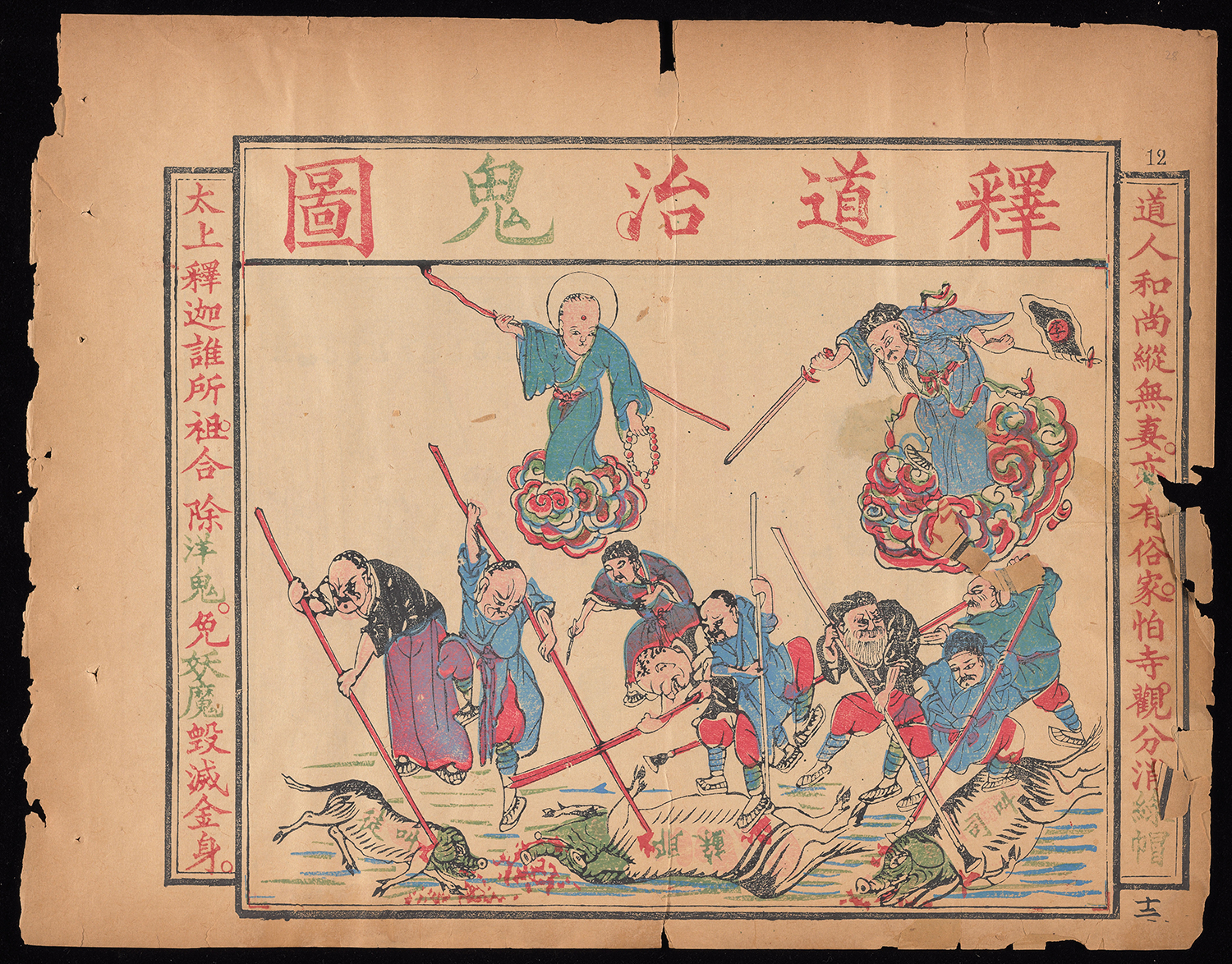 |
Picture 12 Transcription of Caption [cr53] for Picture 12 [cr54]: PICTURE XII. TRANSLATION. Top:—The Priests of Budd and Taou Chasing the Devils. Right:—Though Buddhist and Taouist Priests themselves have not wives, yet their parental homes are among the laity; they naturally have their fears lest the Monasteries and Temples should share in the odium of having something to do with the Green-hats. Left:—Who are they who reverence T'ai Shang and Shih Kia as the founders of their Creeds? Let them unite together and eject the foreign devils, lest the monstrous demons utterly destroy the golden bodies (images) of the gods. NOTE. T'ai Shang is Lao-tsze, the founder of Taouism. Shih Kia is Shakyamuni, the founder of Buddhism. Here both are called upon the combine their strength, and drive the devils out. On the middle pig are the characters Ye-Su, Jesus. On the right corner pig are the characters Kiau-Sze, Teacher. On the left corner pig are the characters Kiau-T'u, Disciple. The Cartoon represents the priests of the two religions as united in the work of expelling the Foreign Teachers and Native Converts. Jesus (Christianity) is represented as lying on his back, dead and helpless. On Green-hats, See Cartoon I. Note 3. [cr54_12picture_1891] |
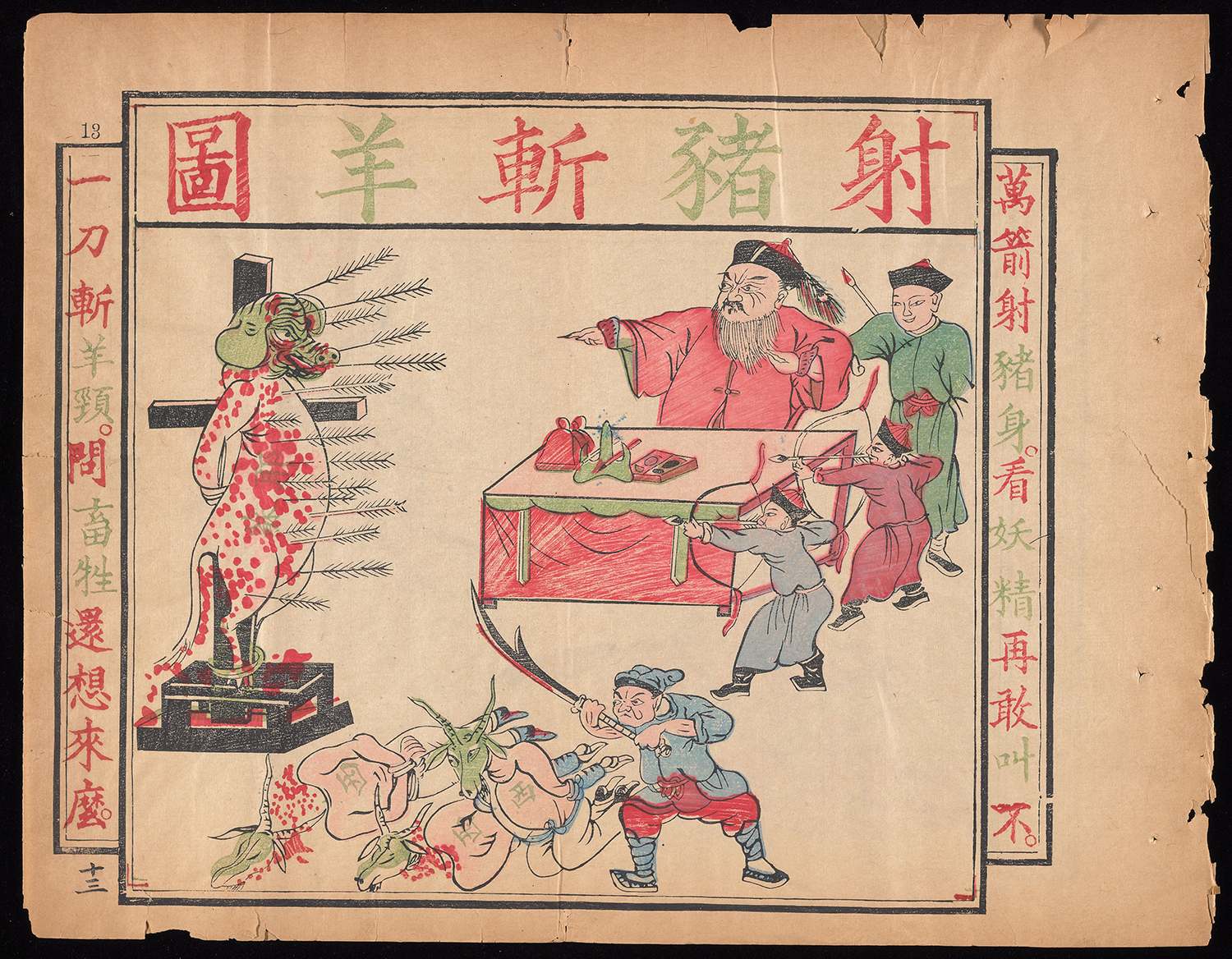 |
Picture 13 Transcription of Caption [cr52] for Picture 13 [cr51]: PICTURE XIII. TRANSLATION. Top:—Shooting the Hog and Decollating the Goats. Right:—The Hog is pierced with ten thousand arrows. See if the Elf dare squeak again. Left:—The goat's neck is severed with one stoke of the knife. Ask the beasts if they still think of coming. NOTE. On the pierced Hog are the characters Ye-Su, Jesus. On the slain goats is the character Si, Westerns. As to the red buttoned Mandarin, who is directing the attack, he may be safely taken for Chou Han. See Cartoon IX. Note 2. [cr51_13picture_1891] |
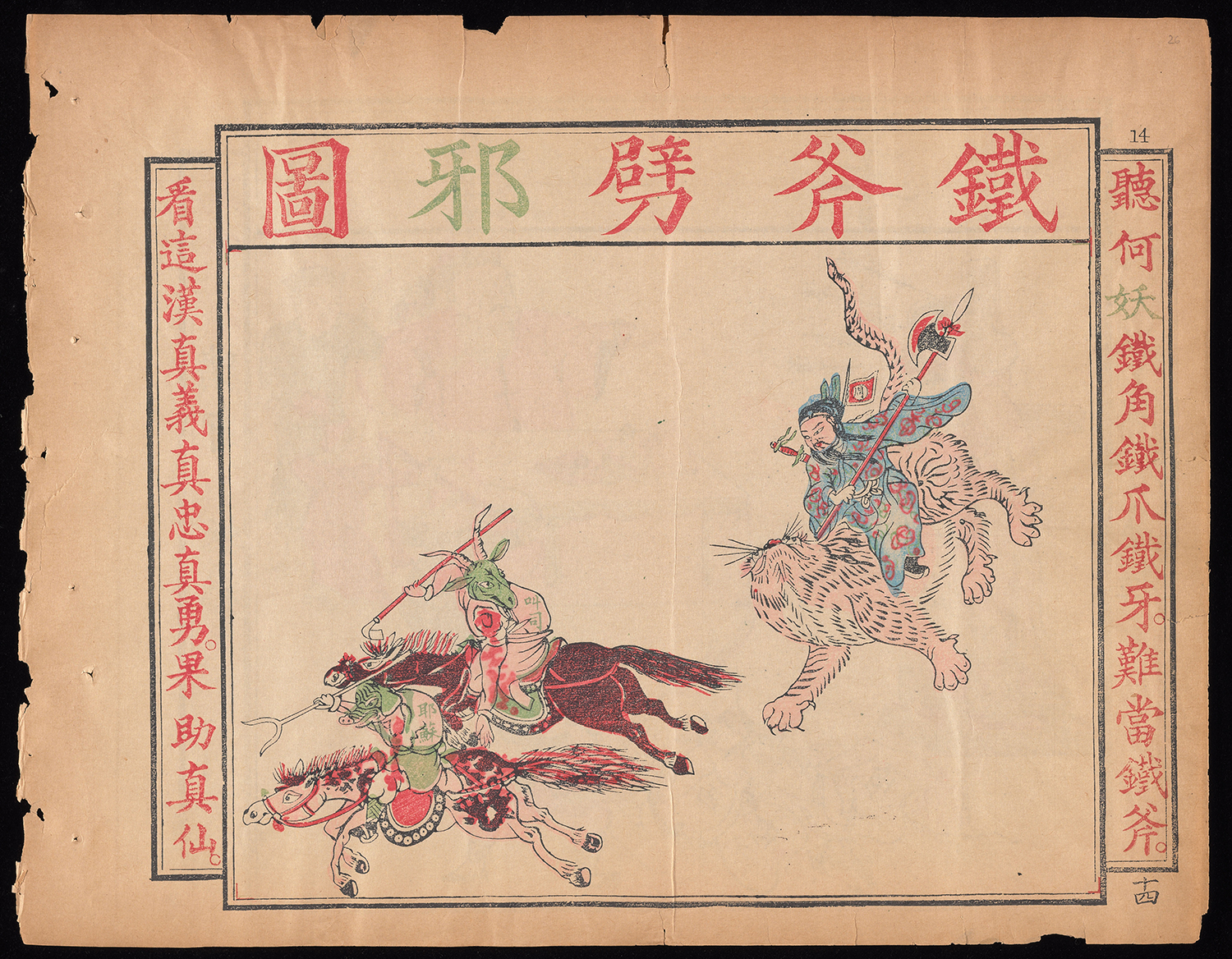 |
Picture 14 Transcription of Caption [cr49] for Picture 14 [cr50]: PICTURE XIV. TRANSLATION. Top:—The Iron Halberd Splitting up Heresy. Right:—Why allow these monsters to have their way? Iron horns, iron claws, and iron teeth cannot withstand the iron halberd. Left:—Look at this hero, 漢! He is truly public spirited, truly loyal, and truly brave; he is surely assisting the Immortals. NOTE. This Cartoon is intended to represent the attitude of the Immortal Genii in regard to the foreigner and his religion. On the pig-headed monster are the characters Ye-Su, Jesus; on the goat-headed monster are the characters Kiau-Sze, Teacher. Both have been wounded by one of the Genii, who is riding on a panther, and is still in hot pursuit, and bent on their destruction. On the flag is the character Chou, 周, and in the text is the character Han, 漢". The two characters form Chou Han, 周漢", the name of the red buttoned Mandarin of Cartoons IX and XIII. In the text he speaks of himself as being able and worthy of assisting the Immortal Genii in this antichristian crusade. [cr50_14picture_1891] |
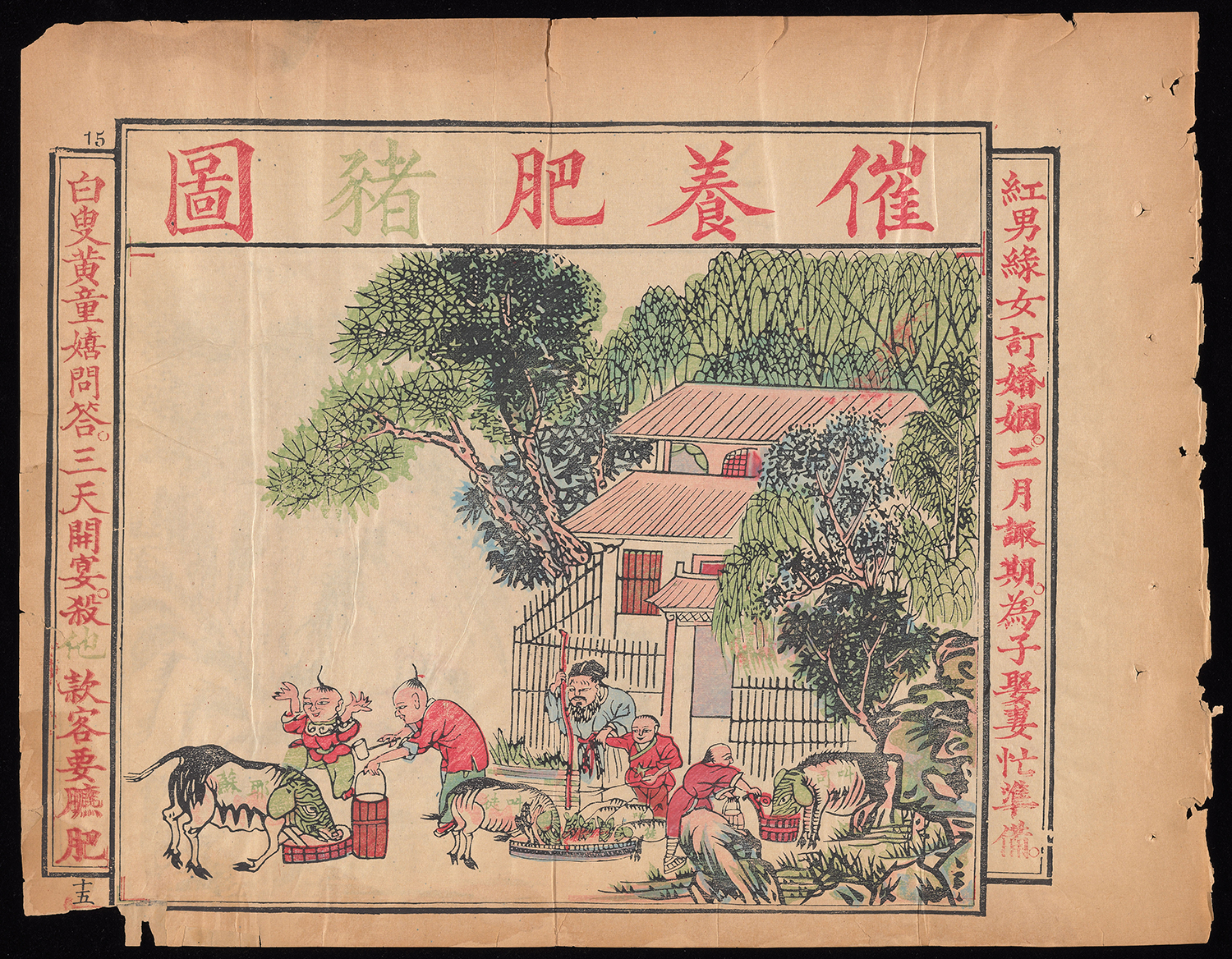 |
Transcription of Caption [cr48] and [cr49] for Picture 15 [cr47]: PICTURE XV. TRANSLATION. Top:—Hasten on the Fattening of the Pigs. Right:—The marriage between the young man and maiden is arranged; the second moon is fixed upon for the event; the son is taking a wife, and the parents are busily engaged in making preparations. Left:—The old people and children are marry-making and chatting; three days hence (they say to each other) the feasting will begin, and we must have the pigs will fattened, to slaughter for the entertainment of our guest. NOTES. 1. This Cartoon might be entitled, “Celebrate Marriages with the slaughter of the pigs.” The pig on the left hand is marked Ye Su, Jesus; the one on the right Kiau Sze, Teacher; and the two in the middle Kiau T’u, Disciples. All are being fed for the coming slaughter, to the great amusement of old and young. 2. Cartoons XV-XX are of a piece, and intended to heap contempt on the foreigner and the foreign religion. They are intended also as a prophecy of the fate which awaits both. The following extracts from one of the Hunan publications, called K’ing-T’ien-Chu 擎天柱, (A pillar which bears the sky), will help the reader in understanding these Cartoons. K’ing-T’ien-Chu contains a petition presented to the Foreign Office at Peking, by a number of the Hunan scholars, and a letter from a Governor of Hunan to the then Viceroy of Chihli. Whether the Governor’s letter is authentic or not, the writer of this note cannot say; but there can be no doubt as to K’ing-T’ien-Chu being one of the best known publications in Changsha, the capital of Hunan. It is also one of the three antichristian books which the Siu-tsai graduates are preaching at the Theatres in Changsha along with the full knowledge of the Hunan officials, we are justified in taking it as authentic. Having acknowledged the receipt of a dispatch from the Chihli Viceroy, communicating the orders of the Foreign Office, to the effect that the publication and circulation of Death Blow to Corrupt Doctrines should be suppressed, the Governor proceeds to state that the book in question is to be found in every family, and in all the Monasteries and Temples, throughout the entire province of Hunan:—“There is not a city, not a village, not a book shop, not a printing shop, in which the book is not to be found. The destruction of it is impossible. Besides it has, for its first chapter, the seventh section of the Emperor’s Sacred Instructions (Sheng-Yü). Who among the officials of the Great Pure Dynasty would dare burn it? Who could have the moral hardihood to burn it? When I first bought the book, just as I was beginning to read, I saw that the Treatise was headed with the words Sacred Instructions (Sheng-Yü). I thereupon burnt incense, knelt down, and began to chant; then I got up, sat down and read. Having turned the leaves over and over again, and carefully examined, I saw that its noble words and perfect reasoning were simply an expansion of the Sacred Instructions. It commanded my most profound respect. As soon as my official duties were over, I knelt down and chanted the Sacred Instructions; then I got up, sat down and read the book. I dared not treat it with the least disrespect.” The Governor further proceeds to state that orders for the destruction of Death Blow to Corrupt Doctrines must have been caused by ignorance of its true nature, on the part of both the Chihli Viceroy, and the Foreign Office. Speaking of himself, however, he states:—“As for me, having bought and read this book, and knowing perfectly that it is a helpful commentary on the Sacred Instructions, were I immediately on the receipt of your dispatch, to order the officials under my jurisdiction to act according to your orders, then, what sort of a man would the officials and the people under my charge take me to be? And what sort of a man would I take myself to be? To gladden the heart of the barbarians, by feeding the flames of depraved doctrines, destroying the Sacred Instructions, injuring the dignity of the Empire, opposing propriety and throwing into confusion the five cardinal virtues, corrupting public morals and injuring good manners, and thus sin against the renowned doctrine (of Confucius), and hand down a stinking reputation to all future ages—the is a certainly what I dare not do and cannot do, though it should cost me my life. Moreover, there are printed and circulated in Hunan, several hundred different kinds of antichristian books, ballads and cartoons; Death Blow to Corrupt Doctrines is not the only book. Married women, maidens, and little children three years old, all hate the Hog Jesus. When they call the pigs, they use the word Ye-Su (Jesus); eating pork they call ‘eating the flesh of Jesus;’ in transacting business at the butcher shop, they all use the expressions ‘selling Jesus,’ ‘buying Jesus.’ This is attacking the depraved religion to the utmost. Though the books and the blocks of this one book should be burned, how can the depraved religion of the Celestial Hog enter Hunan?” Some quotations have been given already from the infamous Death Blow to Corrupt Doctrines. One more may be given, in order to show the kind of article this is, in which the Governor found so much to his taste:—“Priests (Roman Catholic) are, for the most part, educated from their childhood. They are emasculated. Those who enter their religion practice sodomy with the priests without restraint, this is called ‘adding to knowledge.’...They are not allowed to marry two wives, because they say that God originally created but one man and one woman, so they have neither second wives nor concubines though they practise adultery without restraint. When a wife dies, they then take another. When a father dies, his son may marry his mother; when a son dies, his father may marry his daughter-in-law. A man may also marry his own daughter. They marry the widows of decreased brothers, uncles, or nephews; they also marry their own sisters. ... Brothers and friends seldom see each other, but when they meet, they give themselves up to licentious intercourse; they call this ‘reunion of original elements.’” See Death Blow to Corrupt Doctrines, Teng Cheu Translation. The following from the same work is altogether too filthy for translation. Here it is as it stands in the original:—凡夷中男婦與從教者交均諳采戰術曰乞 仙以口吸成童精與處女經水曰開天孔又曰人劑與人交臂宿即知人隱衷乘機害 之曰測隱. Such is the book, over which the Governor gloats, and before which he felt he must fall on his knees and burn incense. His statements regarding the attitude of the Hunan people, with respect to Christianity, are as wide of the truth as is his description of the book. It simply suited so to represent the matter. The chapter in Death Blow to Corrupt Doctrines from which the above extract is taken reappears in a work just published, called Kiu-ming Kin-tan, 救命金丹. This book is beautifully printed; but whether in Hupeh or in Hunan it is impossible to say. It is known, however, that the copy now in possession of the writer of this note came from one of the wealthy business firms in Hankow. [cr47_15picture_1891] |
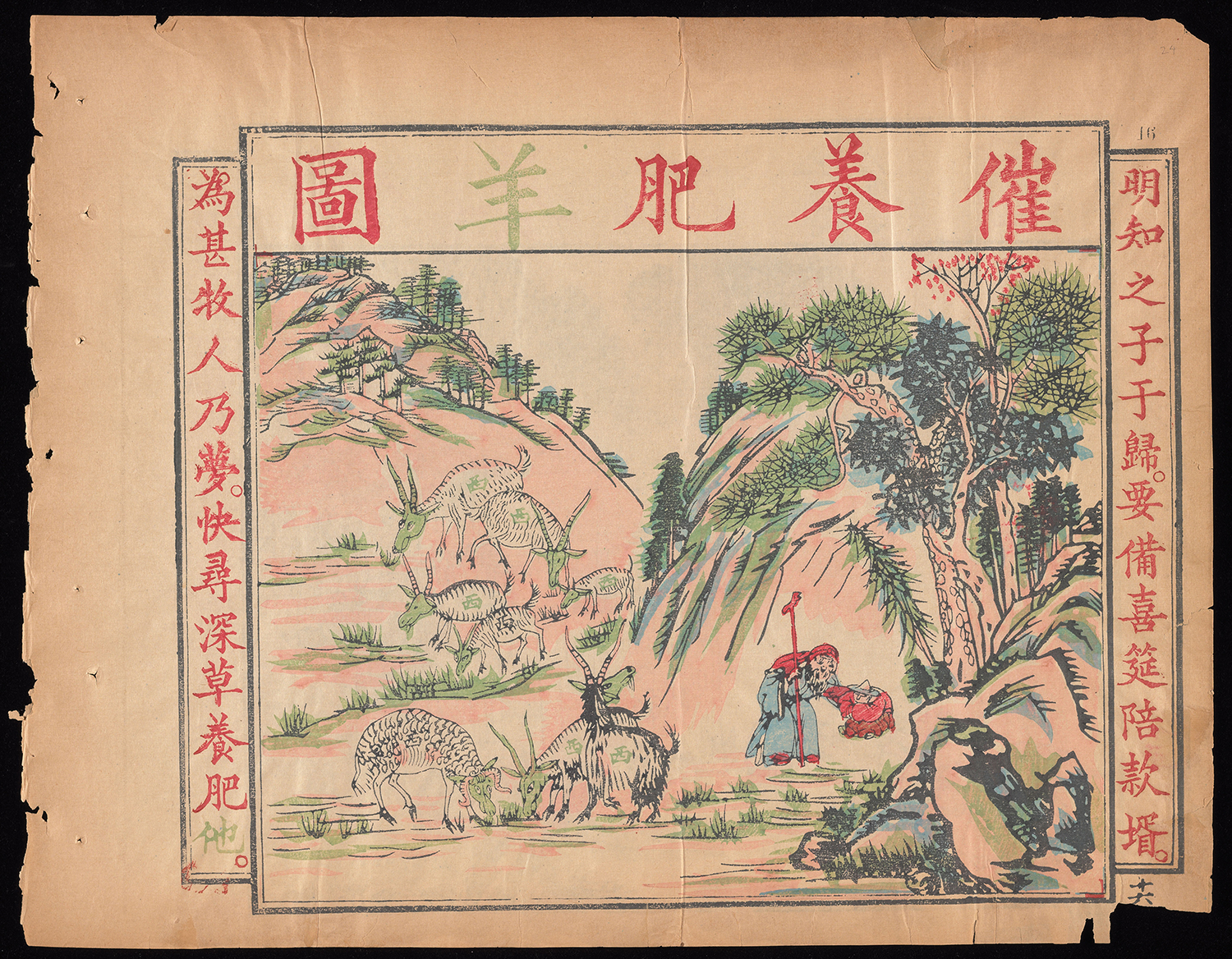 |
Picture 16 Transcription of Caption [cr45] for Picture 16 [cr46]: PICTURE XVI. TRANSLATION. Top:—Hasten on the Fattening of the Goats. Right:—You know that the young lady is going to her future home. Make ready a merry feast for the worthy reception of the son-in-law. Left:—Why do the shepherds dream? Quickly seek rich pastures, and fatten the goats. NOTE. This Cartoon might be entitled, “Celebrate the coming of the bridegroom with the slaughter of the goats.” On each of the goats the character Si, 西, i.e. a Western or a Foreigner. The old man is supposed to be shaking up the sleeping dreaming shepherd. The idea of the Cartoon is that the foreigners are being prepared for slaughter, and that everything ought to be done to hurry on the event. See Notes on Cartoon XV. [cr46_16picture_1891] |
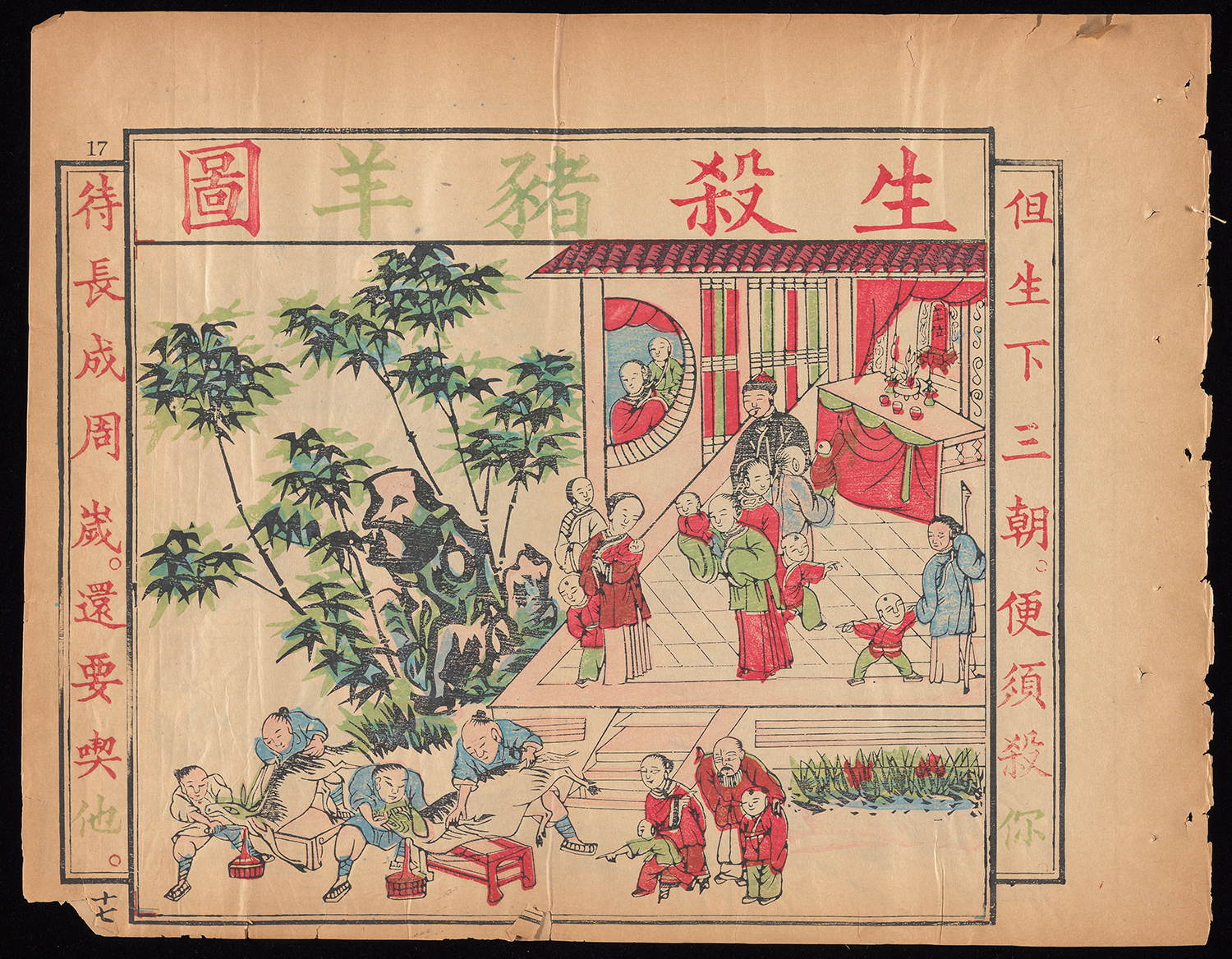 |
Picture 17 Transcription of Caption [cr44] for Picture 17 [cr43]: PICTURE XVII. TRANSLATION. Top:—When a Son is Born Slaughter the Pigs and Goats. Right:—When the child is three days old we will kill you. Left:—When the child is one year old we will eat them. NOTE. “You” and “them” refer to the pigs and goats. i.e. Christians and foreigners. The Cartoon might be entitled, “Celebrate births with the slaughter of pigs and goats.” The pig is marked with the character Ye-Su, Jesus, and the goat with the character Si, 西, a Western of Foreigner. See Notes on Cartoons XV, XVI. [cr43_17picture_1891] |
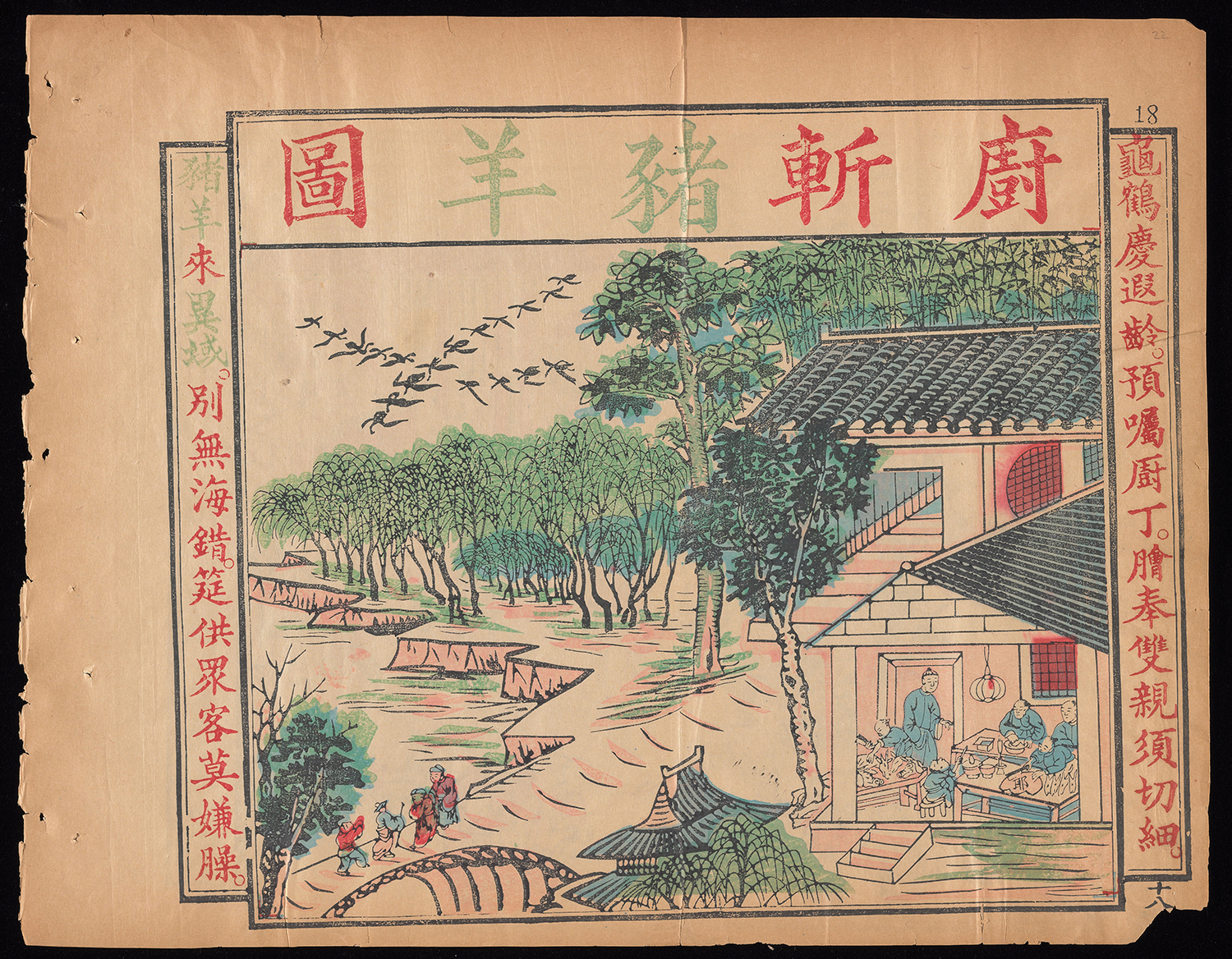 |
Picture 18 Transcription of Caption [cr41] for Picture 18 [cr42]: PICTURE XVIII. TRANSLATION. Top:—The Cooks Decollating the Pigs and Goats. Right:—The Tortoise and Stork are to be congratulated on their longevity. Give timely orders to the cooks, and tell them that the minced meat to be presented to Father and Mother must be cut quite small. Left:—These pigs and goats come from foreign lands. We have no other dainties to feast our guests with. Please excuse the rancid fare. NOTES. 1. This Cartoon might be entitled “Congratulate Old Age with the slaughter of the pigs and goats.” Birthdays are not celebrated in China with any great eclat, until the age of fifty is reached; after that, on the return of every birthday, there is generally a feast to which some relatives and friends are invited. On the occurrence of every tenth birthday, after reaching fifty years of age, special attention is paid to the day. Wealthy people, after arriving at the age of fifty, have extraordinary celebrations of that, and every tenth returning birthday. The tortoise and stork are emblems of longevity; here they refer to the aged parents, whose birthdays are being celebrated. 2. On the right of the cartoon, is the kitchen, where the cooks are busily engaged in cutting of the heads of the pigs and goats, and chopping up the meat. On the piece of meat is the character Ye-Su, Jesus. One the left are to be seen some of the guests, who have come to congratulate the old people on the auspicious occasion. See Notes on Pictures XV, XVI, and XVII. 3. The rancid fare. Goat flesh and mutton are distasteful to the Chinese in these parts, and always spoken of as strong and rancid. The reference to the foreigner is obvious. [cr42_18picture_1891] |
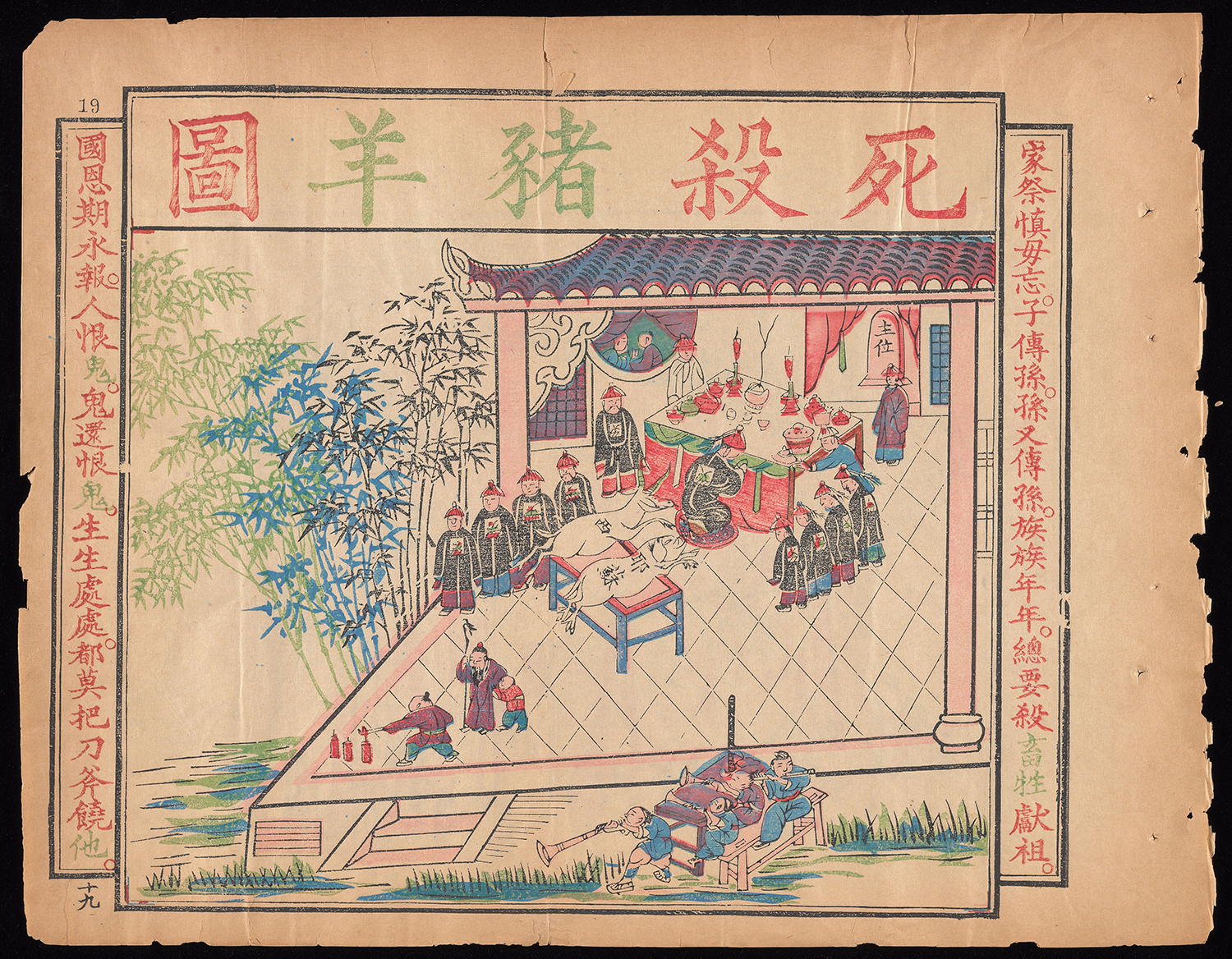 |
Picture 19 Transcription of Caption [cr40] for Picture 19 [cr39]: PICTURE XIX. TRANSLATION. Top:—When Parents Die Slaughter the Pigs and Goats. Right:—Be careful not to forget the family sacrifice. Let the sons transmit the rite to the grandsons, and the grandsons again to the great grandsons. Every clan, year by year, must slaughter the beasts (foreigners and christians), and present them in sacrifice to their ancestors. Left:—The Emperor’s kindness must be ever-lastingly requited. Living men hate the devils (foreigners), and the spirits of dead men hate the devils. Always and everywhere let not the knife and hatchet spare them. NOTE. This Cartoon might be entitled “Sacrifice to the dead with the slaughter of the pigs and goats” i.e. Christians and Foreigners. Here we have an Ancestral Temple; at the end is the shrine with its Spirit Tablet, 主位, and in front if it a table bearing candles, incense, and offerings. A Mandarin is kneeling before the tablet, and behind him are two victims which are being offered in sacrifice. On the pig are the characters Ye-Su, Jesus, and on the goat the character Si, Western or Foreigner. The sacrifice is carried on in the midst of music and fire crackers; it is a season of great rejoicing. See Notes on Pictures XV-XVIII. [cr39_19picture_1891] |
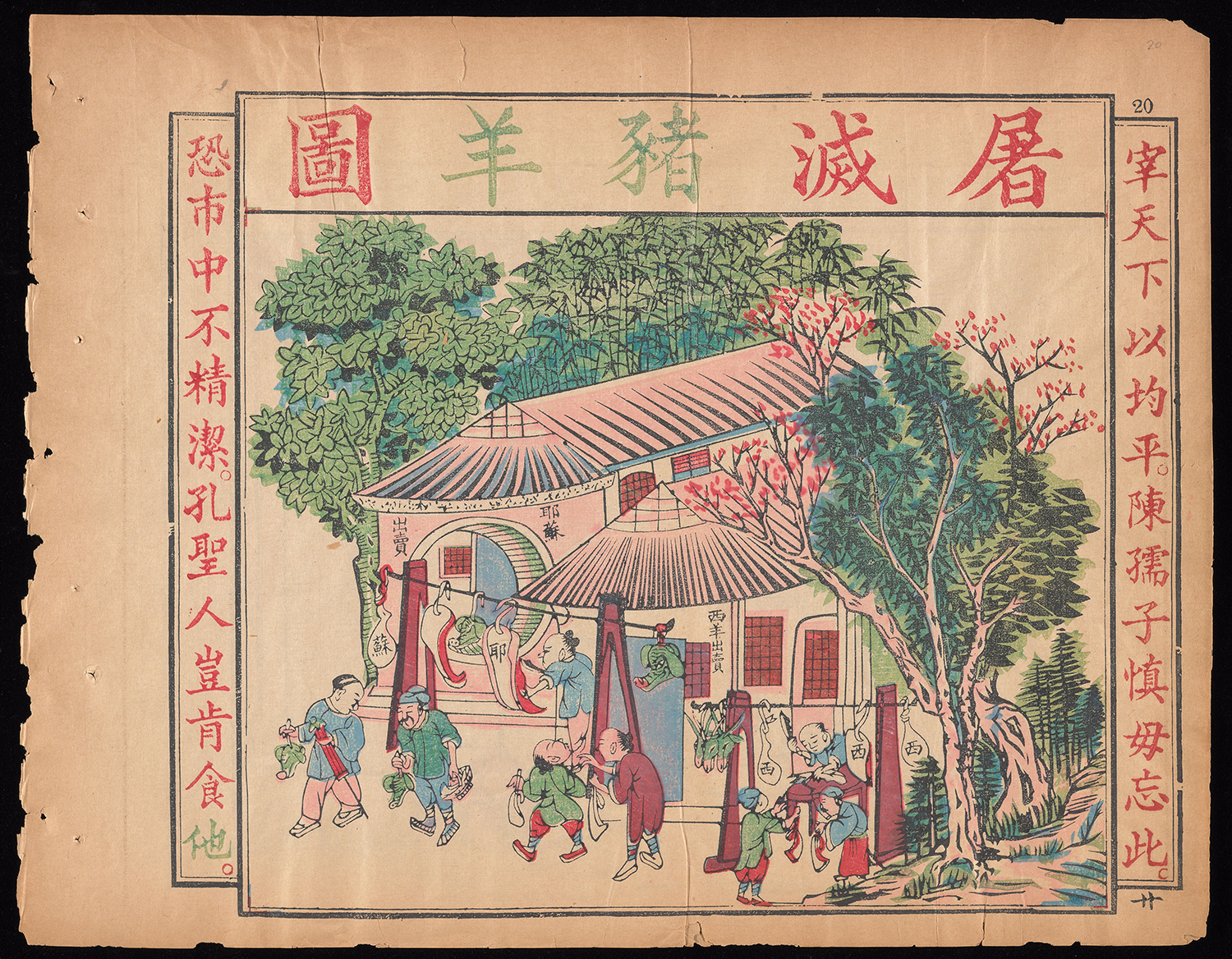 |
Picture 20 Transcription of Caption [cr37] for Picture 20 [cr38]: PICTURE XX. TRANSLATION. Top:—The Butchers Exterminating the Pigs and Goats. Right:—Govern the Empire with impartial justice. Chén Ju-tsze was careful not to get this. Left:—Confucius had his fears in regard to the cleanliness of meat bought in the market. Do you suppose he would eat that thing? NOTES. 1. Chén Ju-tsze:— “Chén Ju-tsze was a celebrated adherent, and afterwards minister, of the founder of the Han Dynasty. Occupying, in early life, a station of the humblest sort, he raised himself, by devotion to study and his superior talent to the leadership in his native village, where a man of wealth voluntarily bestowed his daughter upon him in marriage. The duty falling upon him of dividing among his fellow villages the flesh of the animals slaughtered, 宰, he performed this task with such impartial justice as to evoke the wish on their part that he might rise to be the chief minister, 宰, of the Empire.” See Meyer’s Chinese Reader’s Manual. The play here is one the word Tsai, 宰, which means to govern or rule, and also slaughter and dress animals. The butchers are called upon to imitate Chén Ju-tsze, and perform their work with impartial justice. 2. In the Lun Yü we read that Confucius did not partake of wine and dried meat bought in the market, hence the reference here. If he would not partake of the market meat on account of its possible want of cleanliness, is it likely that he would partake of the filthy stuff? 3. These are two Butcher shops or stalls, where the butchers are chopping and selling goatflesh and pork. On one stall we have the characters Ye-Su ch’u mai, 耶穌出賣, Jesus is sold here; on the other are the characters Si Yang ch’u mai, 西羊出賣, Foreign goat sold here. The pork is all marked Ye- Su, 耶穌, Jesus; the goat meat is marked Si, 西, Western or Foreigner. Read Notes on Cartoon XV. for explanation. [cr38_20picture_1891] |
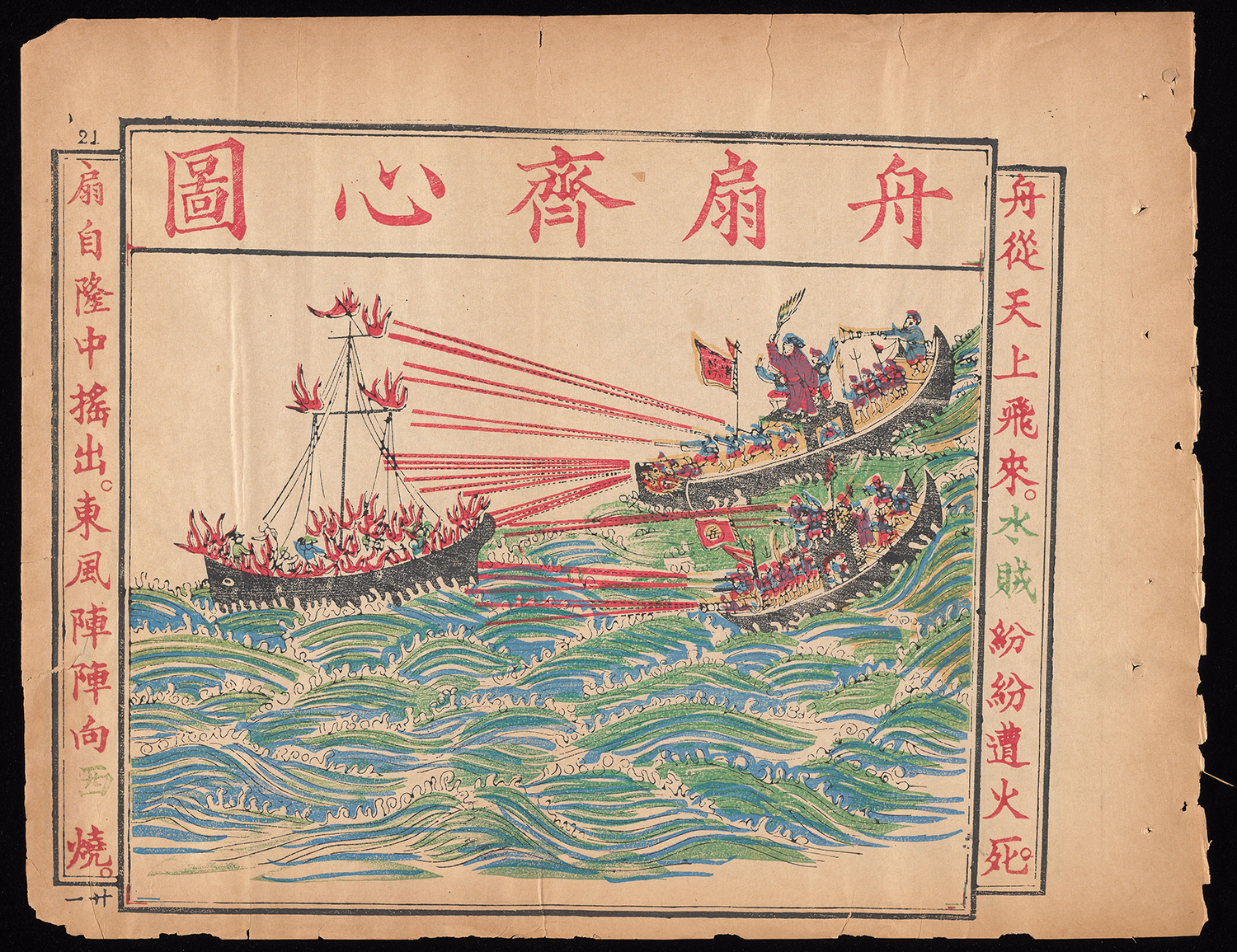 |
Picture 21 Transcription of Caption [cr36] for Picture 21 [cr35]: PICTURE XXI. TRANSLATION. Top:—The Boat and Fan United in Heart. Right:—The boat comes flying from heaven; the water thieves have all perished in the fire. Left:—The fan comes brandishing from Lung Chung; the east wind goes puff- puff toward the West, burning up the ships. NOTES. 1. On the Left is a foreign ship; on the right are two Chinese gun boats, one bearing the flag of Yoh Fei, 岳飛, and the other, the flag of Chu Ko Liang, 諸葛 亮. The former is set on fire and completely destroyed by the latter. 2. Yoh Fei, A.D.1103-1141, was a celebrated commander during the struggles of the reign of Sung Kau Tsung against internal revolt and the encroachments of the Tartars of the Kin Dynasty. He was inflexibly opposed to the policy of making peace with the “barbarians,” and this trait in his character is extolled by the Chinese historians equally with his courage and military skill. This one reason why he is introduced here. Another reason is that the notorious pirate Yang Yau was killed by him on the Tung-ting lake in Hunan, and all his followers scattered. Yoh Fei thus gave peace to the whole region of the Tung-ting lake and the Siang River. The spirit of Yoh Fei still lives, and the doom of the water thieves (foreigners), should they ever visit Hunan is sealed. 3. Chu Ko Liang, A.D. 181-234, was the great counsellor of Liu Pei, the founder of the Shuh Han, 蜀漢, Dynasty. Liu Pei owed much of this success in establishing himself on the throne to the sagacity and military skill of Chu Ko Liang. When sought out by Liu Pei, he was found (A.D. 207) inhabiting a small hut at Lung Chung. After serving Liu Pei until the death of the latter with unbroken fidelity, he continued to be the counsellor and generalissimo of the deceased sovereign’s son and successor. It is said that on one occasion Cheu Yü wished to attack Ts’au Ts’au, but could not do so for want of East wind. Chu Ko Liang ascended an altar and sacrificed. In an instant Cheu Yü saw all his banners beginning to flutter in the wind. He thereupon sailed Westward and defeated the enemy. 4. This Cartoon represents Chu Ko Liang, with his magic fan in hand, as directing the attack on the foreign ship. He is the fan from Lung Chung, a mountain in Siang Yang, Hupeh. The winds are under his command. Yoh Fei is in the other boat (a heaven sent boat), and his hatred of the “barbarians” will never die. Both Yoh Fei and Chu Ko Liang being with Hunan in fighting the water thieves, what has Hunan to fear? [cr35_21picture_1891] |
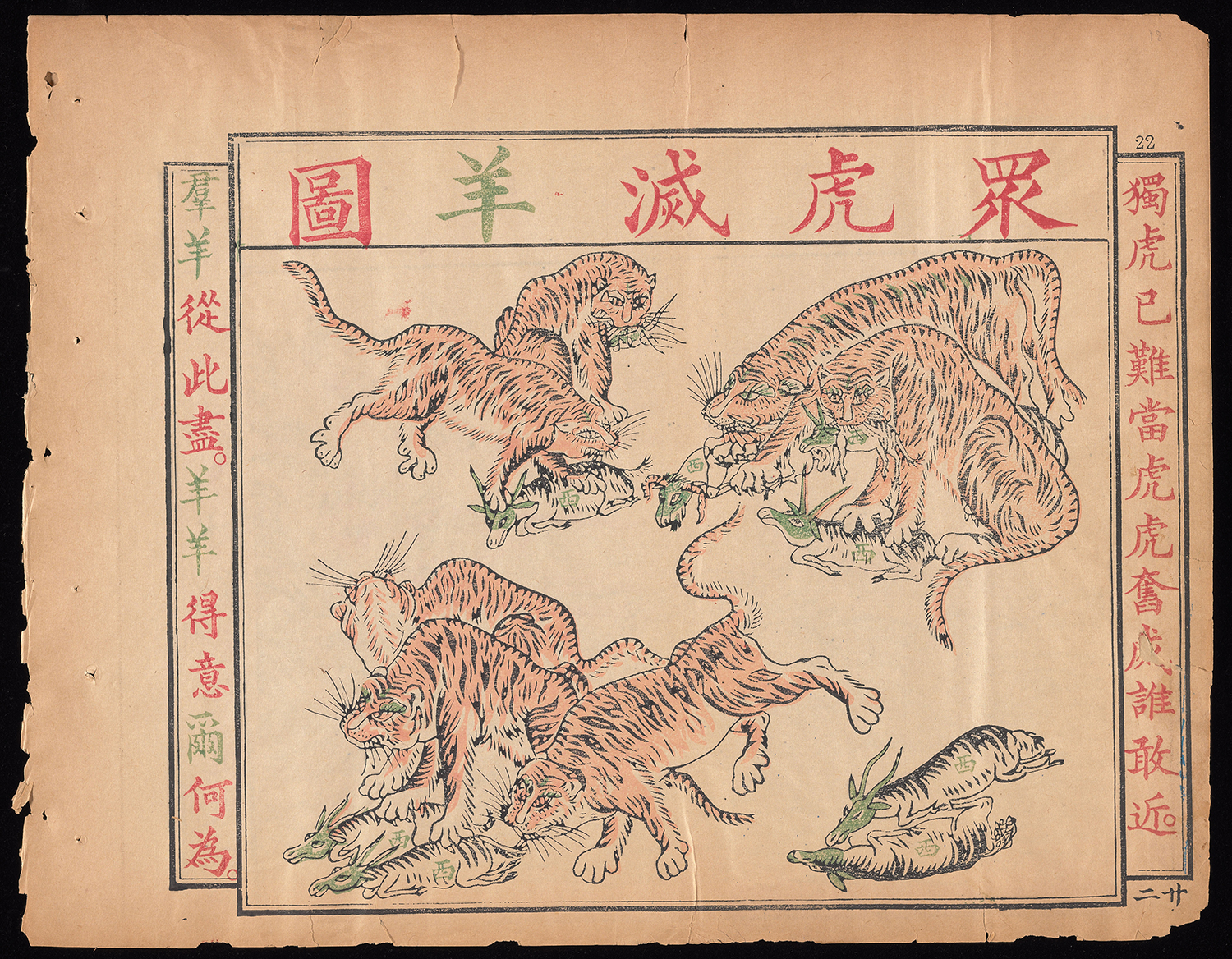 |
Picture 22 Transcription of Caption [cr33] for Picture 22 [cr34]: PICTURE XXII. TRANSLATION. Top:—All the Tigers Exterminating the Goats. Right:—To withstand one tiger is difficult. When all the tigers rise in awful majesty, who can approach them? Left:—Henceforth all the goats will be no more. Though all you goats have been getting your wish hitherto, what will you do now? NOTE. Each of the goats is marked with Si, 西, Western or Foreigner. The tigers represent the braves. Here the goats (foreigners) are being torn to pieces by the Hunan braves. [cr34_22picture_1891] |
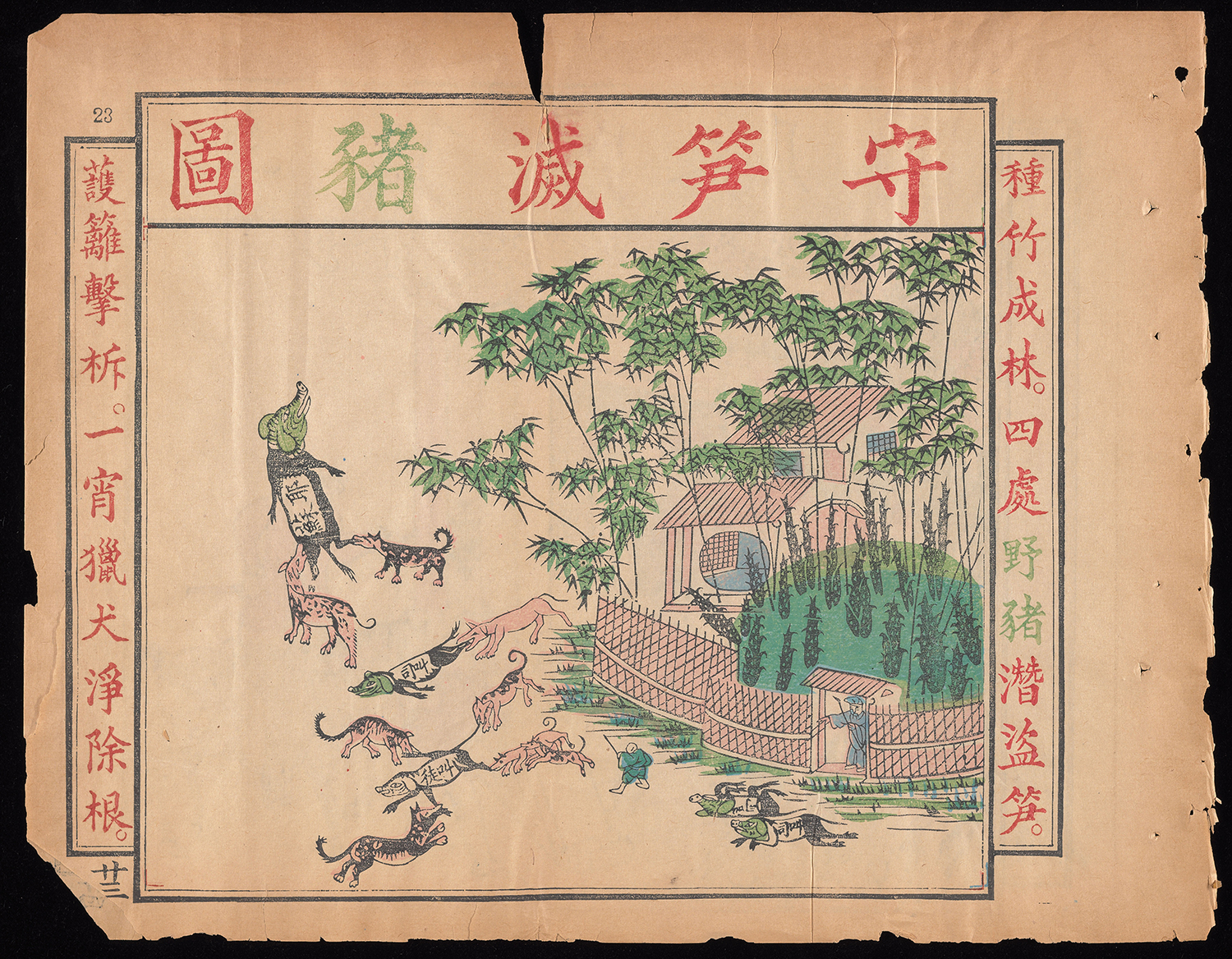 |
Picture 23 Transcription of Caption [cr32] for Picture 23 [cr31]: PICTURE XXIII. TRANSLATION. Top:—The Watchman of the Bamboo Shoots Exterminating the Pigs. Right:—The planted bamboo has become a grove, and the wild pigs come from all quarters, and secretly steal the bamboo shoots. Left:—The keeper of the fence strikes the watchman’s clapper, and in one night the hunting-dogs destroy them (pigs) utterly. NOTE. Hunan is famous for the plentifulness of its bamboo. Foreigners are the pigs, who desire to steal the bamboo shoots (the wealth and trade) of Hunan. But the Hunanese are on the watch. The fate of the foreigners who may attempt to enter Hunan is depicted here. One the big pig are the characters Ye-Su, Jesus. The others are marked Kiau-sze and Kiau-t’u, Teacher and Disciple respectively. [cr31_23picture_1891] |
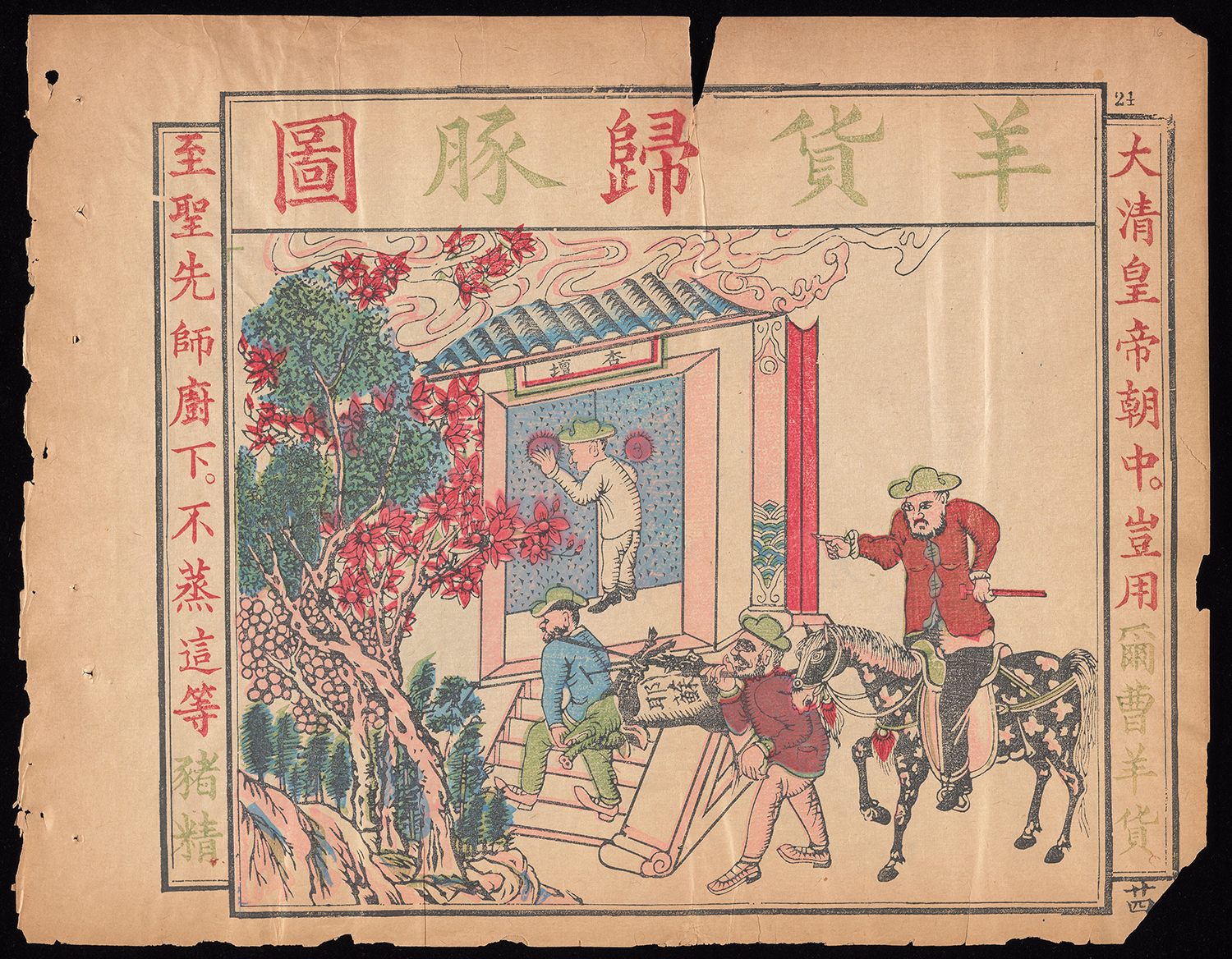 |
Picture 24 Transcription of Caption [cr29] for Picture 24 [cr30]: PICTURE XXIV. TRANSLATION. Top:—Return the Goat-goods to the Pigs. Right:—Do you suppose that your goat-goods are used in the palace of the Great Pure Dynasty? Left:—In the kitchen of the most holy ancient teacher (Confucius) they do not cook such a hog-elf as this. NOTE. Goat-goods, i.e. Foreign-goods. Here the reference is to the Hog (Jesus), or the Christian religion. Over the door at which the foreigner is knocking are the two characters Hing T’an, 杏壇, (Apricot Altar), the name of a place where Confucius had a school. Two foreigners, directed by a third, are carrying the Hog to the door of Confucius, and offering it for sale. It is rejected with anger and scorn. The moral is, “The Confucianists will have nothing of your Christianity.” [cr30_24picture_1891] |
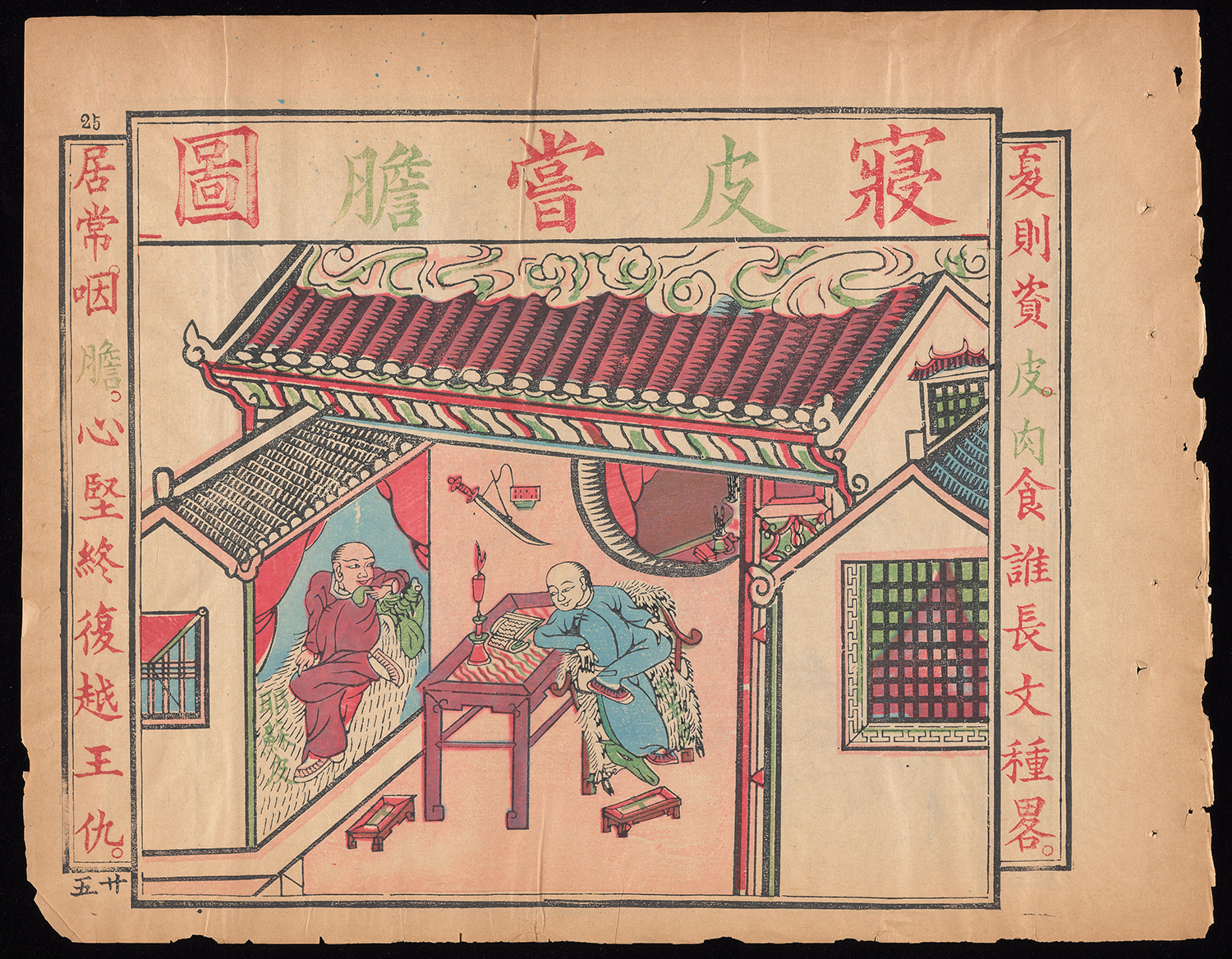 |
Picture 25 Transcription of Caption [cr28] for Picture 25 [cr27]: PICTURE XXV. TRANSLATION. Top:—Sleeping on Skins and Tasting Gall. Right:—In the summer take in the skins (for the winter). Who among the flesh eaters (of the present day) can equal Wen Chung in counsel? Left:—At home he constantly drank gall. His heart was firm in the resolve to have his revenge on the enemies of Yuëh Wang. NOTES. 1. Wen Chung, Yuëh Wang. Yuëh Wang is Keu Tsien, 勾浅, a prince of the state of Yuëh, who succeeded to the throne B.C. 496. Wen Chung was one of his Ministers. Yuëh Wang was defeated in battle by the prince of Wu; after which event he retired into his own state, and in the midst of great self abnegation, much toil, and hardships of various kinds, prepared himself and his people for another struggle. His courteous bearing towards the worthy among the scholars, his great liberality to strangers, and constant kindness to the poor, won all hearts. After more than twenty years training, his people were prepared for the fight. He led them against the prince of Wu, and obtained a complete victory. He thereupon annexed the State of Wu to his dominions, and tendered his allegiance to the dynasty of Cheu, then ruling on the North of the river Yang-tsze. The Cartoon represents him as sipping gall, and Wen Chung sitting opposite to him, both nursing their revenge. The moral of this seems to be, “Let us wait patiently like Yuëh Wang; though we may have to wait long, the day of vengeance will come.” 2. Both Yuëh Wang and Wen Chung are sitting on skins. On the one are the characters Ye-Su p’i, the skin of Jesus, and on the other Si Yang p’i, the skin of the Western goat (foreigner). On each of the footstools is a cross. Yuëh Wang and his minister are made to sit on the skins and tread on the cross, in order to pour contempt on both foreigners and the Jesus whom they worship. In the Tso Chuen we have the expression “As to those two they are like beasts whose flesh I will eat, and then sleep upon their skins.” The author of the Picture Gallery had that passage in view when drawing this Cartoon. 3. The flesh eaters. This expression here has a convert meaning. In the Tso Chuen we have the expression “The flesh eaters are poor creatures, and cannot form any far reaching plans.” The flesh eaters in the text are those useless officials who are partial to foreigners, or who though not partial have not the brains and courage to devise plans for their expulsion. 4. In the summer take in the skins (or furs) for the winter, that is be ready betimes. Don’t let the winter come upon you before providing against its cold. These worthless officials say “it will be time enough by and bye.” But the men who say so, are mere flesh-eaters, bread and butter ministers, utterly devoid of foresight, skill, and daring. [cr27_25picture_1891] |
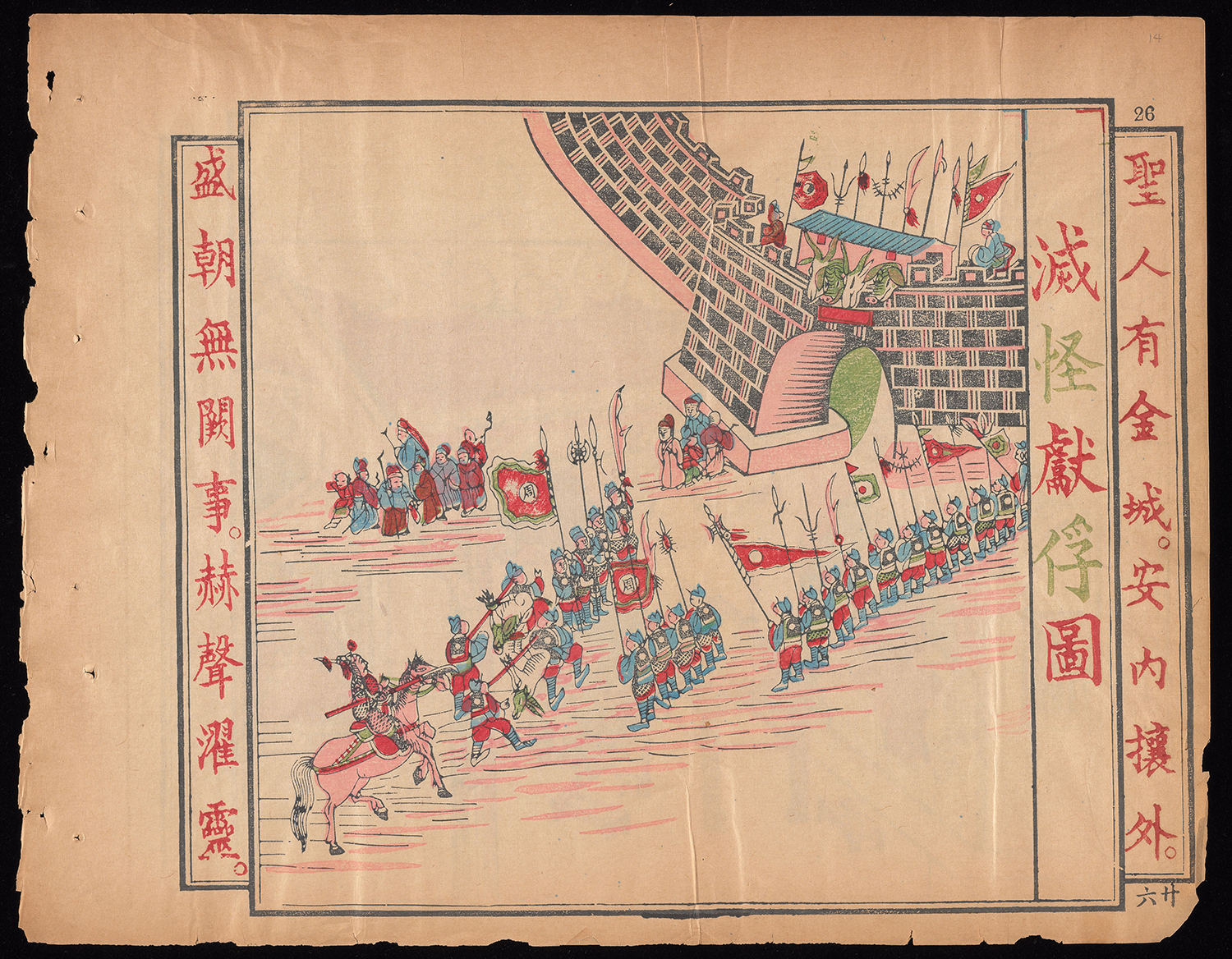 |
Picture 26 Transcription of Caption [cr25] for Picture 26 [cr26]: PICTURE XXVI. TRANSLATION. Top:—Exterminating the Monsters and Offering up the Captives. Right:—The holy man (The Emperor) has a strong city. He gives peace to those within, and expels those that are from without (the barbarians). Left:—Our flourishing Dynasty lacks in nothing. Its fame is glorious, its power is great. NOTE. On the banners is the character Chou, 周. The Mandarin on horseback is probably Chou Han, 周漢, himself. He has been engaged in fighting the foreigners, and is now returning in triumph. The heads over the city gates, are the heads of the goats and pigs (foreigners) slain by him. Two captives in the shape of a goat and a pig are being carried before him. This is a grand triumphal procession. [cr26_26picture_1891] |
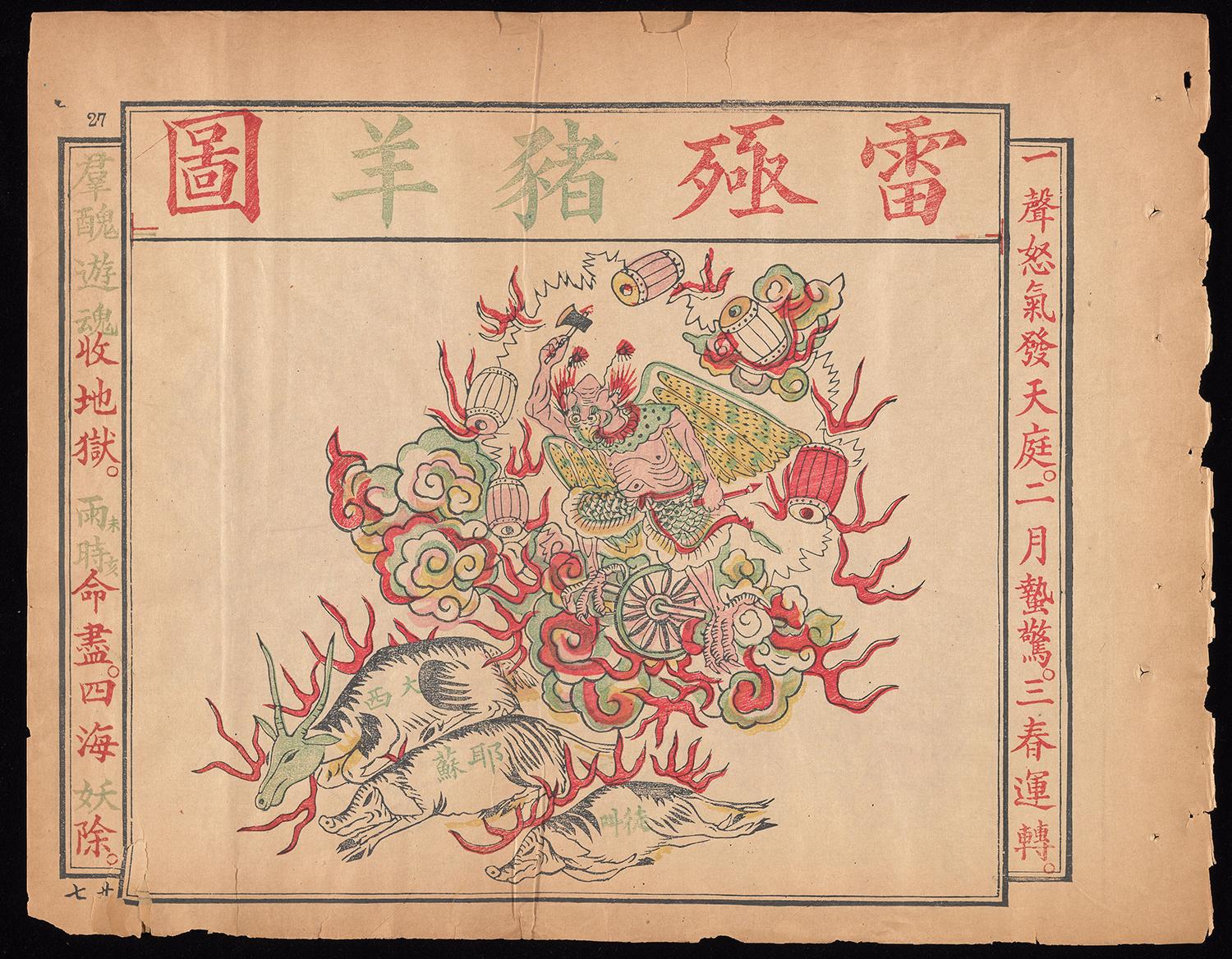 |
Picture 27 Transcription of Caption [cr24] for Picture 27 [cr23]: PICTURE XXVII. TRANSLATION. Top:—The God of Thunder Destroying the Pig and Goats. Right:—With one angry clap of thunder from the court of heaven the torpid insects are excited and the spring returns. Left:—The wandering ghosts of the ugly crowd are gathered into hell. The term of life allotted to the goats and pigs is exhausted. From all within the four seas (China) the monsters have been driven out. NOTE. The goat is marked Ta Si Great West, and the pigs are marked Ye-Su Jesus, and Kiau-T’u Disciple. The God of Thunder is represented as actively engaged in exterminating the foreigner generally, and all Christians whether they be Missionaries or converts. The Missionaries say that the God of Thunder is a myth, and that thunder is a natural phenomenon. He is greatly incensed at this, and determined to have his revenge. “You christians are against the God of Thunder, and the God of Thunder is against you—which, think you, will get the best of it?” that seems to be the moral of this Cartoon. [cr23_27picture_1891] |
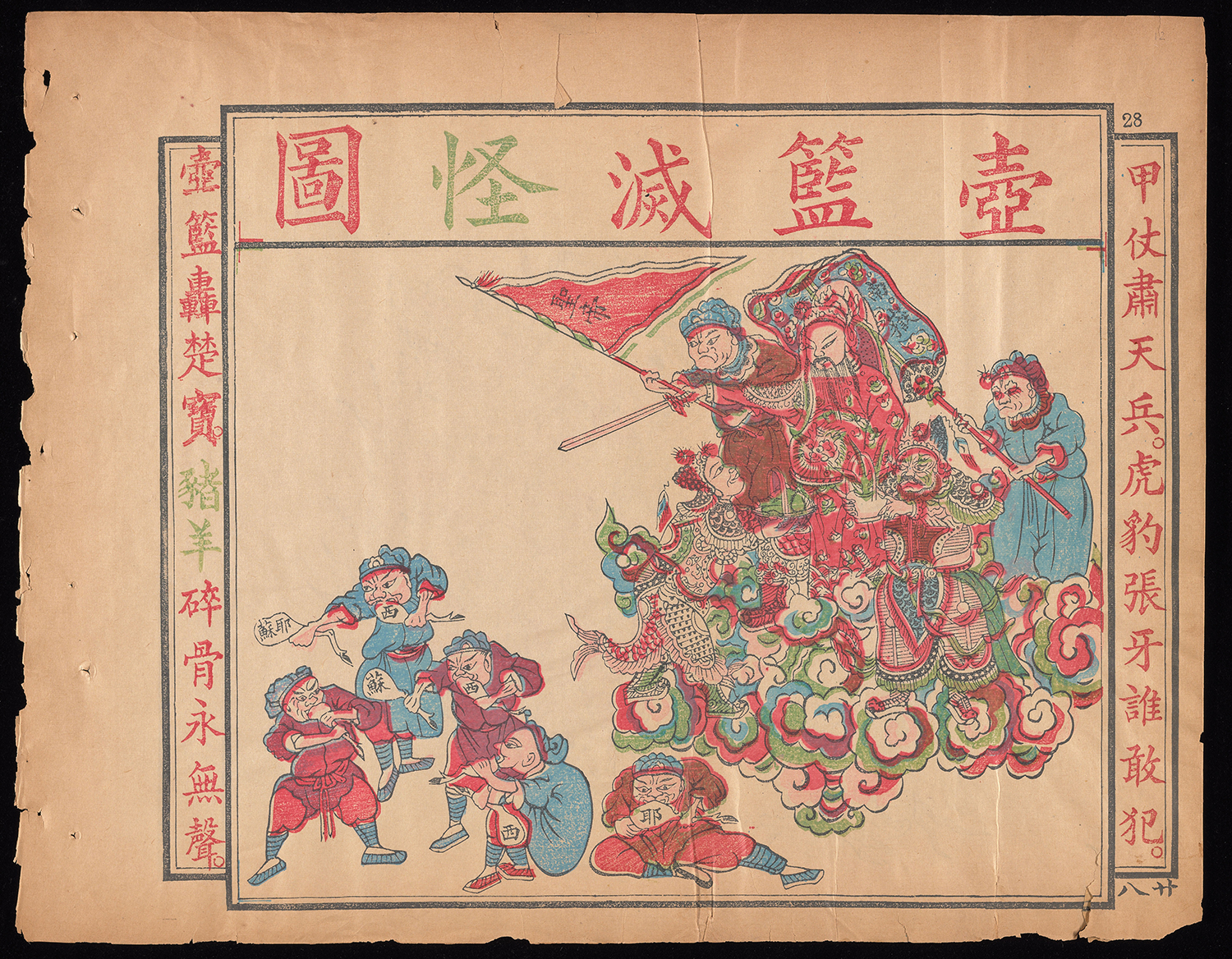 |
Picture 28 Transcription of Caption [cr21] for Picture 28 [cr22]: PICTURE XXVIII. TRANSLATION. Top:—Hunan Exterminating the Monsters. Right:—The awe-inspiring celestial soldiers are armed and mailed. When the tigers and panthers open their mouths who dares oppose? Left:—Hunan sends forth with a thunder clap the precious ones of Ts’u. The bones of the pigs and goats are broken in pieces; their voices will never be heard again. NOTE. 1. The middle of the mailed figures is Nan-yoh Ta Ti, 南嶽大帝, the great god of the Southern mountain. There are five sacred mountains worshipped by the ancient emperors, and venerated by all China. The Southern mountain is Heng-Shan, 衡山, in Hunan. The supreme god of Heng Shan is represented, sword in hand, as actively engaged in exterminating the pigs and goats. On his right and left hands are two of his ministers, presenting on offering the heads of a pig and a goat. On the left of the picture are the celestial soldiers eating the raw flesh of the pigs and goats. The legs and shoulders which the soldiers are grasping in their hands are marked with the characters Ye-Su, Jesus, and Si, Westerns. The characters 壺籃, Hulan, are evidently intended for 湖南, Hunan, the sounds being to the ear of a Hunanese almost identical. The former are used probably for the sake of concealment. 2. In Ta Hioh, The Great Learning, Chap. X we read: “The kingdom of Ts’u (the present Hu Kuang, consisting of Hupeh and Hunan) does not consider that (a famous girdle of Ts’u, called 白珩) to be valuable. It values, instead, its goodmen.” The reference in the text is to this passage. The precious ones of Ts’u are its virtuous ministers and brave men, whom Hunan is prepared to send forth to fight and exterminate the barbarian. [cr22_28picture_1891] |
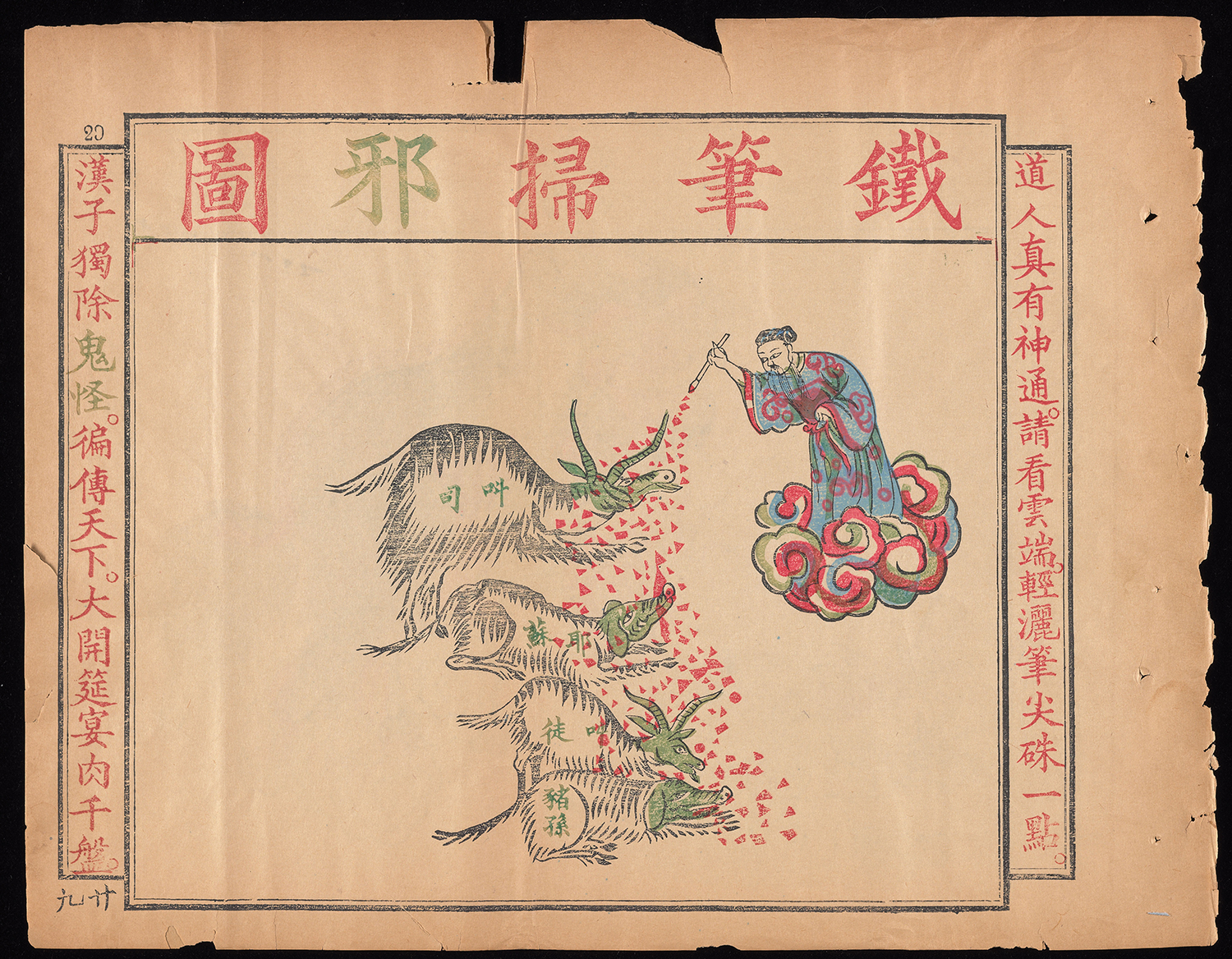 |
Picture 29 Transcription of Caption [cr20] for Picture 29 [cr19]: PICTURE XXIX. TRANSLATION. Top:—The Iron Pencil Sweeping away Heresy. Right:—The priests of Tau are endowed with supernatural faculties. Please look at this cloud. How deftly does he sprinkle the vermillion drops from the tip of his pencil. Left:—This hero, 漢子, is able, single handed, to exterminate the devilish monsters. All under heaven are informed that a great feast of a thousand dishes is about to be spread. NOTE. Here we have a Tauist priest exterminating the Christians by means of his magic art. Reading from the top, the animals are marked Teacher, Jesus, Disciple, Converts. In the text we have the characters Han-Tsze, 漢子, hero. The hero is probably no other than Chou Han, who appears here in the character of a Tauist priest. The pigs and goats are to be slaughtered and out of their flesh a great feast is to be provided for the entertainment of all China. [cr19_29picture_1891] |
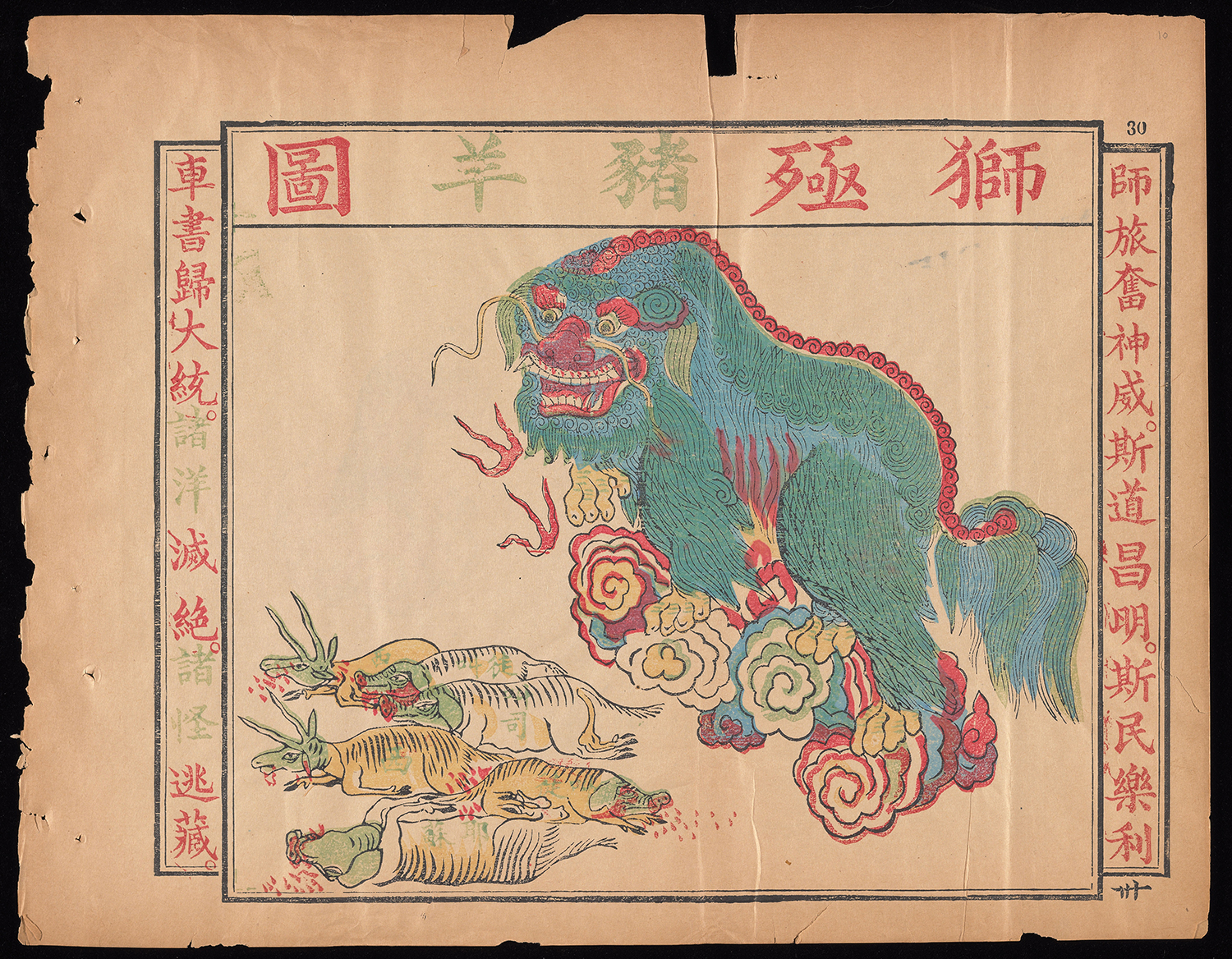 |
Picture 30 Transcription of Caption [cr17] for Picture 30 [cr18]: PICTURE XXX. TRANSLATION. Top:—The Lion Destroying the Pigs and Goats. Right:—Let the troops rise in unwonted majesty; then this doctrine (Confucianism) will brightly shine forth, and this people (the Chinese) will delight in what they (the ancient kings) delighted, and be benefited by their beneficial arrangements. Left:—Carriages and writings will come under one rule; all that is foreign will be exterminated. And all the monsters will flee and hide themselves. NOTES. 1. The lion in this Cartoon symbolizes the military power of China. The goats are marked Si, Westerners, and the pigs with the characters Kiau-Sze, Teacher, Kiau-t’u, Disciples, and Ye-Su, Jesus. The goats and pigs are scampering away as best they can; but Jesus is on his back dead and helpless. 2. In the Chung Yung, The Doctrine of the Mean, Chap. XXVIII, we read: “To no one but the Emperor does it belong to order ceremonies, to fix the measures, and to determine the characters. Now, over the Empire carriages have all wheels of the same size; all writing is with the same characters; and for conduct there are the same rules.” The sentence, “Carriages and writings will come under the same rule.” in the text, has a special reference to the passage in the Chung Yung. Foreigners have brought in confusion in regard to carriages, writings, and manners. All this shall be done away with when the lion shall rise in his might. Then China will be free from all Western innovations, Western religions, Western tongues, Western manners, and Western men. 3. For explanation of Right see Great Learning, Chapter IV. [cr18_30picture_1891] |
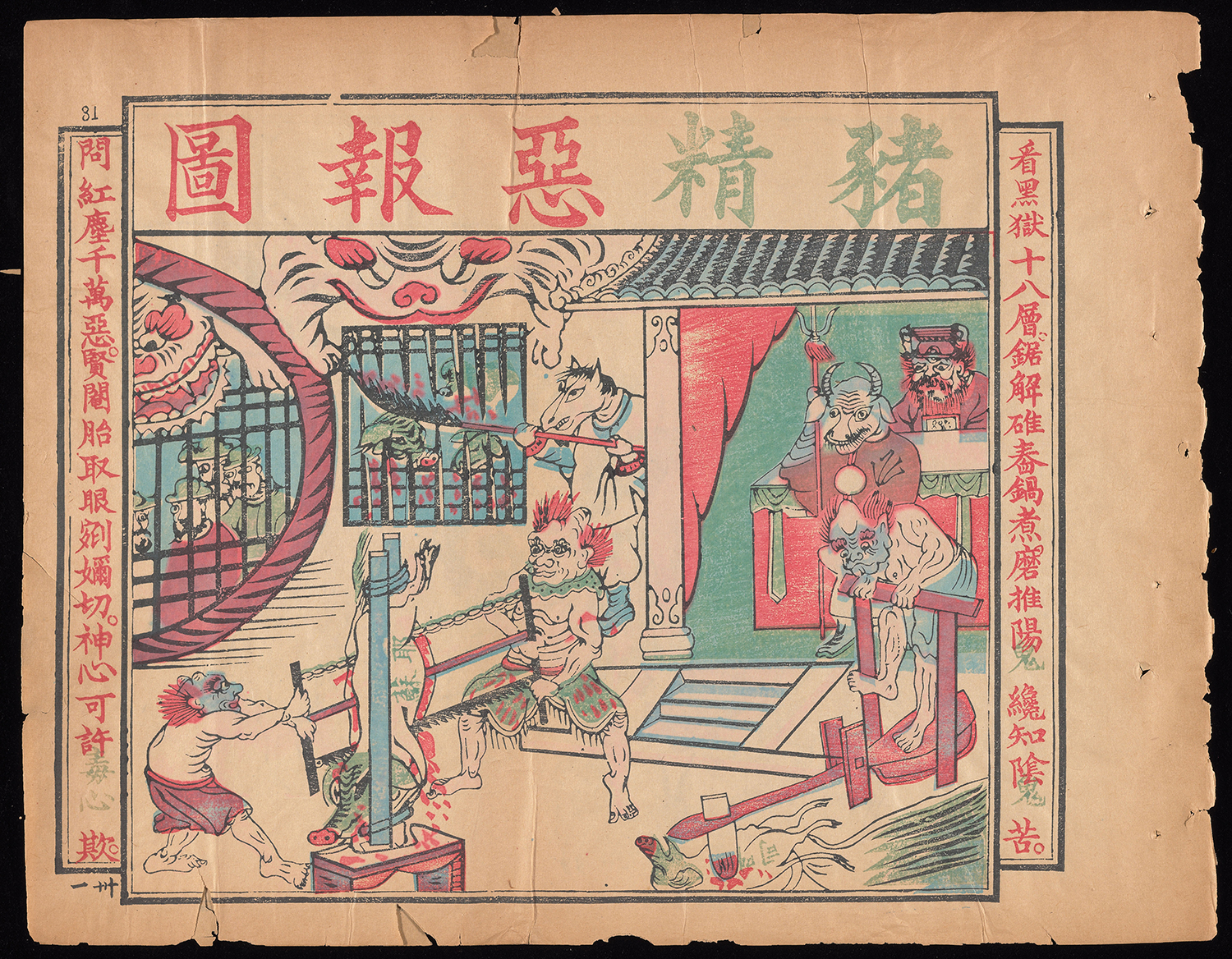 |
Picture 31 Transcription of Caption [cr16] for Picture 31 [cr15]: PICTURE XXXI. TRANSLATION. Top:—The Punishment of the Hog in Hades. Right:—Let them look at the sawing, pounding, boiling and grinding, in dark hell’s eighteen places of torment; then will the devils (foreigners) in this life know the bitterness which the devils (foreigners) in the abode of the dead endure. Left:—You who have on earth committed a thousand times ten thousand deeds of wickedness-castrating boys, extracting the fetus, gouging out eyes, and cutting off the nipples—do you suppose that the cruel mind will be allowed to insult the divine mind? NOTE. Here we are in one of the Chinese hells. Some of the cuckolds and pigs are caged, waiting for their punishment. One of the pigs is being sawn asunder, and the other is being pounded in a stone mortar. On the former are the characters Ye-Su, Jesus, and on the latter Kiau-Sze, Teacher. Three demons are employed in this work of sawing and pounding. The horse-headed and ox-headed demons are superintending the work. Behind the ox-headed demon is one of the kings of hades sitting on his judgment seat. In Death to the Devils’ Religion we read: -- “Everywhere the spirits of holy men have come to the table, and their communications are printed and published they all state clearly that Jesus was an incarnation of the Celestial Hogs; that he was, whilst on earth, most crafty, most wicked, and most lascivious in his conduct; that he plotted the death of his father with the view of usurping the throne; and that he was on this account put to death by crucifixion by the old devil-king of Judea. The kings of hades, hating him with deepest hatred, have imprisoned his soul in darkest hell. Every day he is brought once before one of the kings of hades to receive the bitterest punishment. It is now nearly two thousand years since he has been suffering thus. He is doomed never to see Heaven. When he was nailed to the cross, not the least injustice was done to him. The devils’ children, the devils’ grandchildren, and the devils’ wives, (i.e. converts), when they die, are all, without exception, imprisoned in hell. Since those who die have thus to suffer, will those who are still living go on dreaming, and talk about the depraved devil Jesus, and the devils of his depraved religion (converts), as having gone to heaven? Would not that be to show themselves more stupid than pigs?” The Chinese are firm believers in Spiritualism. It would seem that the scholars of Hunan have been consulting the spirits as to the fate of Jesus and his followers. The above purports to be the reply. [cr15_31picture_1891] |
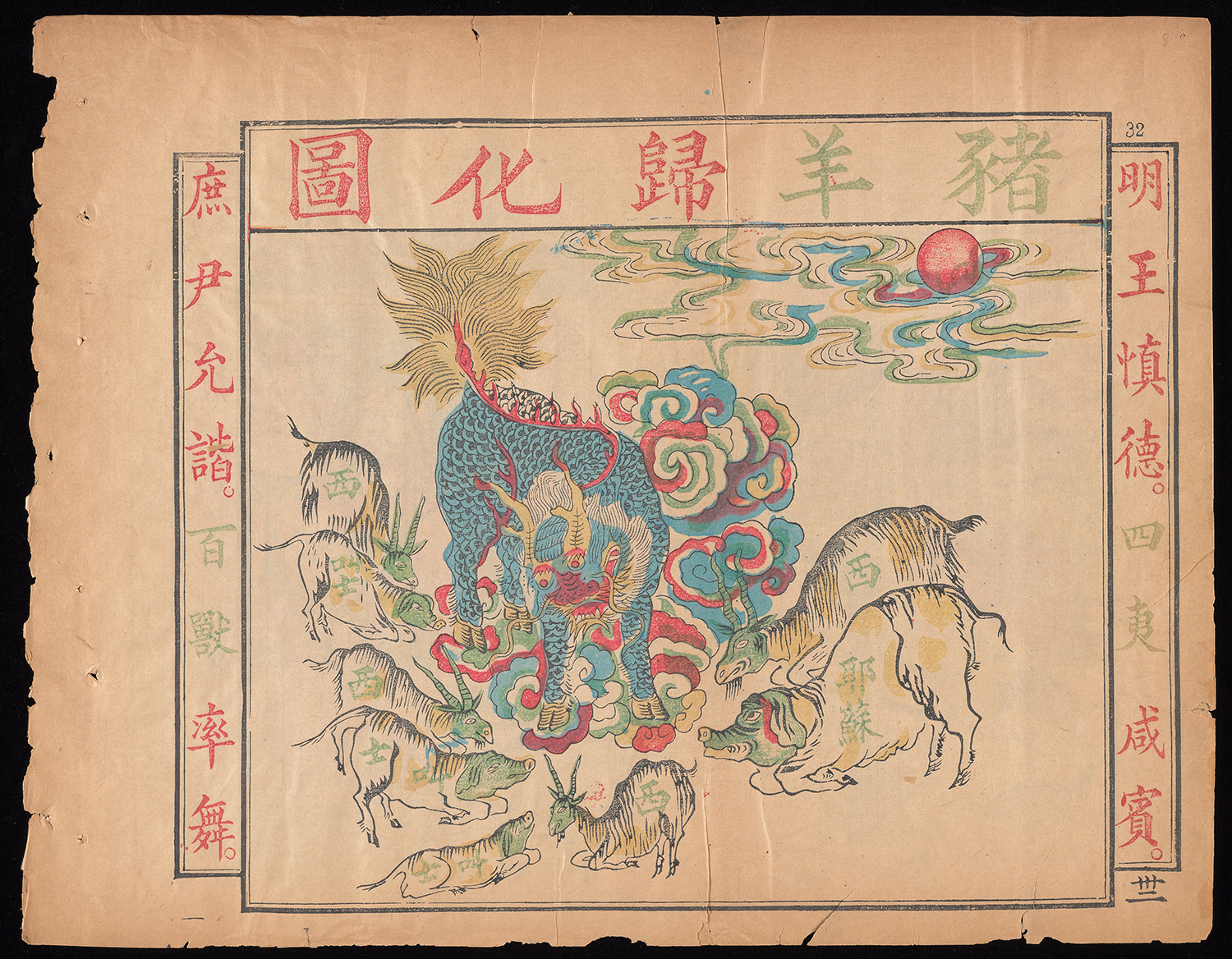 |
Picture 32 Transcription of Caption [cr13] for Picture 32 [cr14]: PICTURE XXXII. TRANSLATION: Top:—The Pigs and Goats Submitting Themselves to the Emperor’s Transforming Sway. Right:—The intelligent kings have paid careful attention to their virtue, and the wild tribes on every side have willingly acknowledged subjection to them. Left:—All the chiefs of the officers are truly harmonious, and all kinds of animals lead on one another to gambol. NOTES 1. These two passages are taken from the Shih-king, the Book of Poetry. The large beast in the Cartoon is supposed to be the K’i-lin, a fabulous monster, and spoken of as chief amongst the quadrupeds. The pigs are marked with the characters for Jesus, Teacher, and Disciple. The Goats are marked with the character for West, i.e. Western, or Foreigner. Both the pigs and the goats are all on their knees before the K’i-lin. 2. Let the K’i-lin stand for the Emperor of China, or the Imperial Sway, and the idea of the Cartoon will become clear. All the refractory foreigners, and all the inflexible Christians, have been exterminated in the various ways already described. Those who remain, have been brought to see and acknowledge the supremacy of China, and the superiority of the Chinese civilization. Christianity humbly bows the knee to Confucianism, and the inhabitants of all lands gladly submit themselves to the benign rule of the Son of Heaven. 3. With this Cartoon the Picture Gallery closes. Whatever opinions may be formed of the work, there can be no doubt as to its value in one respect. It represents faithfully the antichristian argument in China. It is supposed by some that the antichristian writers in this land have studies the nature and claims of the religion which they attack, and that the argument employed by them is based upon knowledge and reason. No supposition could possibly be wider of the mark. The argument, in all its height and depth, length and breadth, is presented here. Anything more false, more foul, and more blasphemous, it would be impossible to conceive; but it is exactly the kind of argument in which the scholars of China delight, and by which the mob in China is moved. [cr14_32picture_1891] |
| Book courtesy of Yale University Beinecke Rare Book & Manuscript Library | Click here for a printer-friendly PDF |
|
Massachusetts Institute of Technology
© 2014 Visualizing Cultures |
 |